The Guide to Deciding on the Best Time to Send a Survey
The Guide to Deciding on the Best Time to Send a Survey
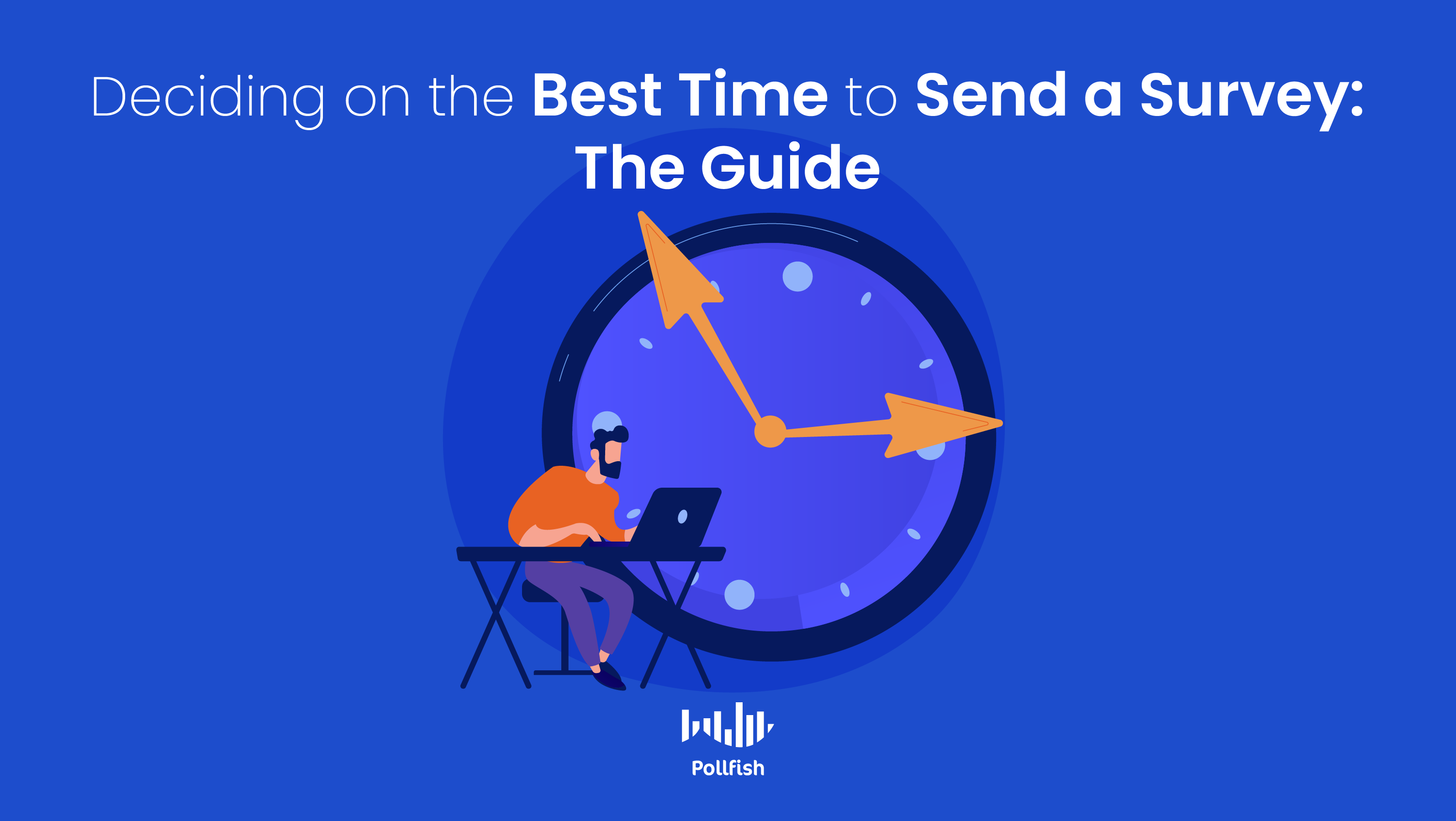
The best time to send a survey to your intended sampling pool may appear to be subjective, but it requires pre-planning to ensure profitable campaigns and outcomes. Businesses should therefore plan their survey deployment strategically.
While it is critical to correctly target your respondents, your company needs to also focus on determining the best time to send a survey so that you sustain an effective survey campaign. This is in part due to the fact that strong survey insights foster positive customer experiences.
A positive CX is a must, as 89% of consumers are more likely to make more than one purchase after a positive customer experience. As such, effective surveys reap critical insights that help brands foster a strong customer experience, among many other benefits.
This article discusses how to decide on the best time to send a survey, so that you never miss the mark on your consumer insights or employee intelligence.
When to Deploy Surveys
While your team can always use insights, you should only deploy surveys for campaigns that require the most immediate answers.
Additionally, these campaigns should be thoroughly fleshed out, meaning that they have specific purposes, goals, KPIs, sub-campaigns and of course, the full-fledged surveys themselves.
The surveys in these campaigns must have all the questions ready to go in the questionnaire and screening portions, along with the quotas set on respondent demographics, devices and all else that the survey platform allows you to define. This way, you can deploy the surveys without having to return to edit them.
While some of this may appear evident, some businesses rush through tasks to which they should have allotted more time. In fact, 20% of businesses are in a hurry to complete their tasks. The adage “haste is waste” can be applied to this scenario, as all business decisions are important and must be fully thought out before they become actionable.
Understanding the Key Moments and Campaigns Best Suited For Survey Deployment
Once you’ve determined the preliminary purpose of your survey study, narrowed down a sub-campaign or two and have prepared a few initial questions, you should pin down the key moments and other possible campaigns to deploy your survey.
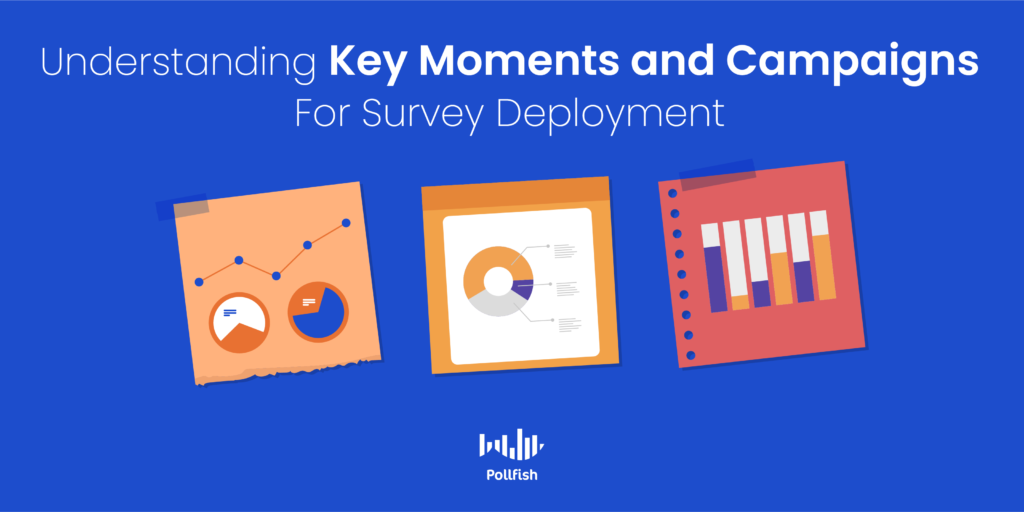
The following provides a high-level overview of a few major campaigns during which businesses should deploy surveys:
- To obtain general consumer insights
- Their thoughts on your industry, niche, competitors or brand
- Their habits, needs, wants and opinions
- When you need to conduct market segmentation
- When you seek to segment your target market into different segments and customer personas
- To get acquainted with your customer behavior
- Forming a customer behavior analysis
- Understanding customer buying behavior
- Prior to the launch of a marketing or other business campaign. This includes:
- Advertising campaigns
- Branding campaigns
- Brand tracking
- Customer development for product testing
- For collecting employee feedback
- For all HR purposes
- To improve company culture
- To boost employee recognition
- Understanding key external entities
- For better understanding partners and vendors
- This involves using B2B surveys
- For conducting event marketing analysis
- To prepare for coming events and gauging past events
- This involves using the event evaluation survey
The Best Time to Send a Survey for Customer Feedback
While there are so many purposes that surveys can be used for, there are none quite as important as those concerning consumer insights. It is the consumers, after all, who carry a business afloat and provide the source of its profits.
Knowing when the best time to send a survey to your customers can result in the difference between a low-quality and insightful campaign. This is because, as important as customer insights may be, some periods in the year or in a week are more opportune to examine customer feedback than others.
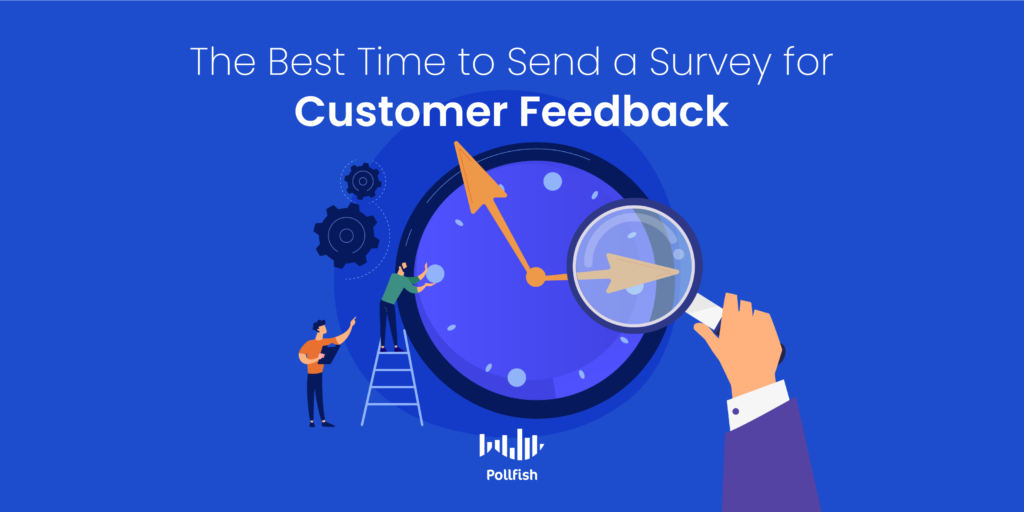
The following explains the best time to send a survey to customers, so that you reap the most insights and keep unwanted, low-insight data at bay:
- During a key milestone in the customer buying journey, for example, when your customer has signed up for a membership, a content subscription, such as a newsletter, or is approaching a patron anniversary with your business.
- After a customer comes in contact with customer service, whether through an online chat, email, phone, or via in-person shopping.
- When customers interact with your business, but wind up making no conversions, such as during cart abandonment, or opting out of signing up after a free trial.
- When customers cut their relationship with a business short during times of dropping out of their customer journey. For example, if a customer cancels a subscription or hasn’t purchased a product they typically would from a brand in a long time.
- When you’re in the midst of innovating on a new product or product feature, service type or customer experience, be it digital, physical or phygital.
You wouldn’t want to send out surveys before you understand the full scope of your project needs, especially when it comes to specific customer intelligence. You must first lay out the specific parameters of those customer intelligence needs.
The Best Time to Send a Survey During the Day
Aside from the proper time to send a survey in relation to a campaign, customer intelligence needs and the readiness of questionnaires, there exists what is known as the best time to send a survey during particular days and hours.
According to a study by CheckMarket, there are specific days of the week and times of the day that are most opportune for sending surveys to your target market. In fact, there are ideal times for sending two main kinds of surveys: B2C and B2B surveys.
You ought to use these specific times as guidelines, as they represent the most appropriate times for respondents to take surveys, which, in turn, shortens the completion time of your survey study.
The following outlines the best time to send B2C and B2B surveys in relation to the time of the week and day.
| B2C Surveys | B2B Surveys | |
| Best Day to Send | Short surveys: Tuesday Long surveys: Wednesday and Friday | Short surveys: Monday Long surveys: Monday, Wednesday, Friday & Sunday |
| Best Time to Send | 6:00 PM- 11:59 PM | Monday: 12:00 AM- 11:59 AM & 3:00 PM - 5:59 PM |
| Thursday & Friday: 3:00 PM - 5:59 PM |
Sending Surveys at all the Right Times
There is far more to ensure that your intended respondents take part in your survey campaign aside from finding your survey at the correct time. The most important aspect of the survey campaign is the online survey platform you use.
This is because this platform allows you to create and deploy the surveys. As such, you should choose an online survey platform that offers superior capabilities, such as random device engagement (RDE) sampling to reach your respondents in their natural digital environments, artificial intelligence and machine learning to disqualify poor-quality survey data and fraud, along with mobile-first design to optimize the mobile experience, given that mobile traffic is dominant, and much more.
Such a platform will ensure that you not only reach your target audience at the right time, but that a highly targeted group partakes in the survey and you receive only the highest quality responses.
Cutting the Customer Attrition Rate with Surveys
Cutting the Customer Attrition Rate with Surveys
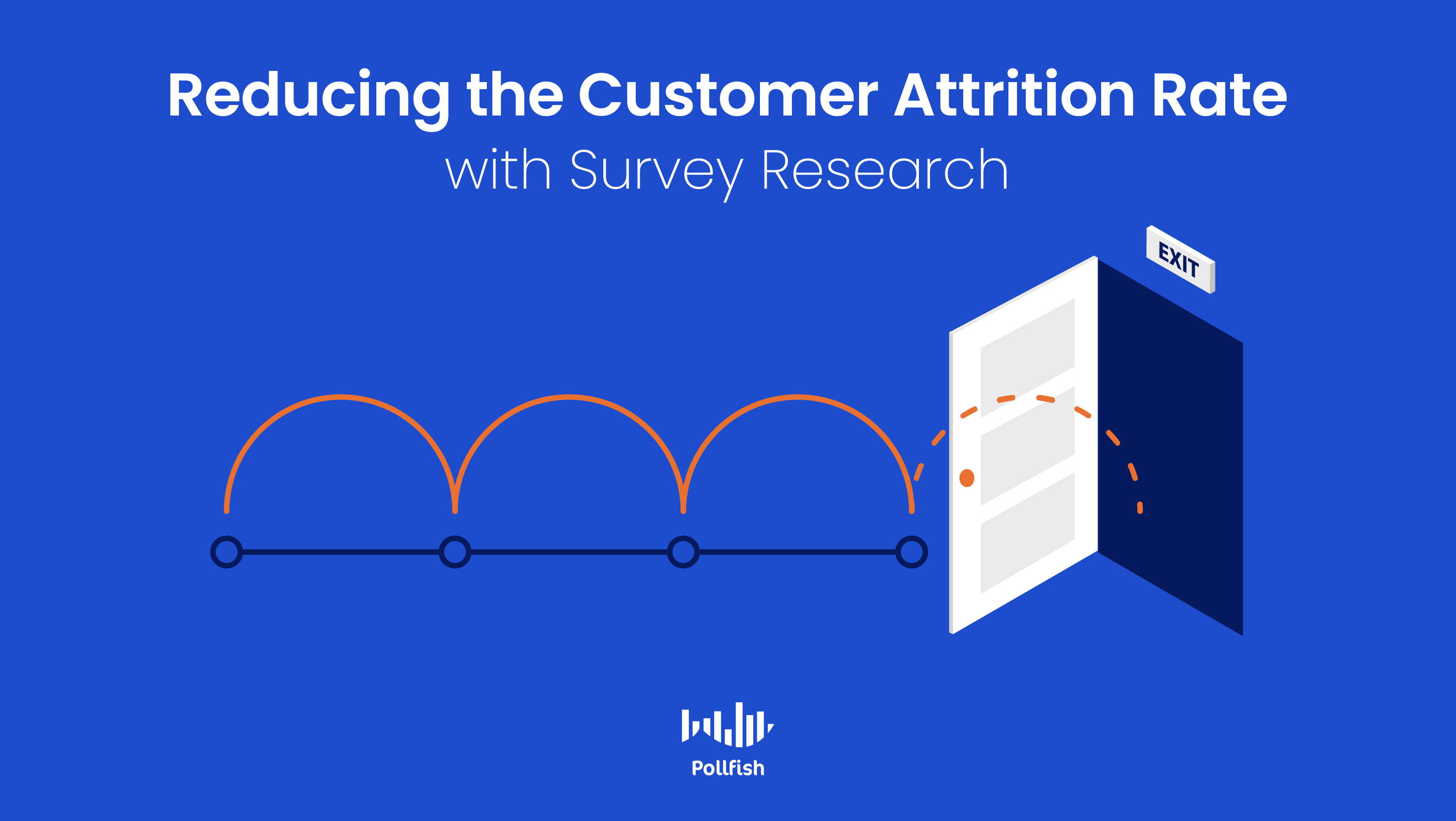
Brands must monitor their customer attrition rate regularly, as customer attrition occurs in all businesses. Gauging the rate at which customers churn, this measurement is crucial to keep track of, as it directly affects subscriptions, sales, revenue and a company’s general stance in regards to its customers.
23-30% of all American companies lose their customers annually, due to a lack of consumer loyalty. This rate alone is severe, yet it only measures customer attrition that springs from a lack of consumer loyalty, pointing to many other existing reasons that cause customers to churn.
Another cause behind customer attrition is customer service, as 71% of consumers end their relationship with a business due to poor customer service. While the loss of a customer will vary from business to business in terms of value, the average value of a lost customer globally is $243.
These figures present the serious consequences and implications of customer attrition. Businesses can nip it in the bud or at the very least, stay aware of it by studying its metric.
This article explains the customer attrition rate, the importance of studying it, its two main types, how to calculate it, how surveys help reduce it and more.
Understanding the Customer Attrition Rate
Interchangeably called the customer churn rate and customer turnover rate, this rate refers to the percentage of customers lost within a given time period, which can be weekly, monthly or annually. Although this metric is typically defined by customers, it can also be defined by products.
Although this rate is used interchangeably with the customer churn rate, it should not be confused with it, as the customer churn rate focuses solely on lost customers, whereas the customer attrition rate considers both how many customers were lost and how many were gained during a specific period.
This rate is the antithesis of the customer retention rate, which measures the number or percentage of customers that a business retains over a given period of time. Ideally, the attrition rate ought to be kept as low as possible in order to sustain higher retention rates and keep a business profitable.
Consideration of the attrition rate is especially important for businesses with recurring revenue models, such as SaaS companies and subscription-based businesses. In these businesses, the customer attrition rate refers to the number or percentage of service subscribers that discontinue their subscriptions in a given time period.
However, all companies ought to monitor this rate, as all companies lose customers, even some of the most loyal. In addition, there are also customers who make one-time purchases. All in all, customer retention is not guaranteed and a customer relationship with a business is rarely, if ever, permanent.
The Importance of Studying the Customer Attrition Rate

This rate is crucial to track periodically and most importantly, to keep it at a minimum. There are various factors that make up the importance of studying this metric and keeping it low.
First off, it is crucial to track this rate, as every lost customer requires acquiring a new one. While important as well, customer acquisition is more expensive and not as convenient as customer retention, as it costs 5 times more to acquire a new customer than it does to retain an existing one. Existing customers are also far more valuable, as customers will pay up to 57% more on brands they are loyal to.
Although acquisition costs are required in sales, marketing, advertising and customer onboarding efforts, retention is still more profitable, as merely a 5% increase in retention rates can reap 25-95% in extra profit.
Customer acquisition can be difficult, but winning back a lost customer is even more difficult, as the damage has already been done and they’ve made up their minds. The loss of customers is also obviously harmful to revenue and can therefore reduce profits significantly.
Next, this metric is necessary to check, as it is a key performance indicator (KPI) that businesses need to stay aware of to ensure that they are making the correct decisions in their strategic planning process and beyond. To this end, this rate also affects a business’s ROI.
It is possible for some customer acquisition expenditures to represent a negative ROI for a company, which represents a loss of money for the company. This occurs when a business substantially invests in its customer acquisition efforts, yet new customers don’t stick around for long enough.
Another reason behind the importance of performing a customer attrition analysis is that if a customer attrition rate is too high, it may be due to a fundamental problem with a company’s offering. It may also signify problems in other areas, such as customer experience, the products and services, the prices and more.
Additionally, it is critical to measure this rate, as a high customer attrition rate often carries a far-reaching impact, which can manifest in reputational damage.
When more and more customers become unhappy and leave a business for good, a significant chunk of them will make their unhappiness known and spread it to the public — whether through social media, review sites, forums, comments on blogs and other digital properties or simply poor assessments via word-of-mouth.
The Two Kinds of Customer Attrition
There are two forms of customer attrition; it is vital for marketers and market researchers to differentiate the two of them. The two forms are active customer attrition and passive customer attrition.
Active Attrition
This kind of attrition is typically associated with subscription business models. These include businesses in the SaaS, telecom, publishing and Internet industries. Active attrition occurs when a customer cancels their subscription to a SaaS product, a phone line, a magazine, a newspaper, an app, a streaming service, etc.
A business’s retention experts who are tasked with lowering active attrition have an advantage: they know precisely when a customer is going to leave. This allows them to carry out marketing tactics bent on changing the customer’s mind. These include lowering subscription costs, offering free add-ons and more.
The disadvantage lies in having to change the minds of consumers who have decided to churn, as there is no guarantee that even the most aggressive marketing techniques will bring back this patronage.
Passive Attrition
Passive attrition refers to the phenomenon of a customer who simply stops buying from or engaging with a business. This kind of attrition is predominantly associated with e-commerce websites, retail stores, on-request service providers and other kinds of non-subscription-based businesses.
There is a major challenge in reducing passive attrition, as it relies on predicting when a customer is about to leave. At times, marketers and market researchers will be able to pinpoint “churn signals” before a customer leaves. In this instance, they can perform marketing techniques to prevent customers from churning.
This involves providing customers with relevant offers and otherwise enticing them to remain active customers. There are also times in which businesses can regain lost customers. However, it is typically more feasible to retain customers with a risk of leaving than it is to regain customers who have churned.
How to Calculate the Customer Attrition Rate
Calculating the customer attrition rate is a simple process for many businesses, especially subscription-based businesses and agencies, as they hold lists of active clients. These kinds of businesses can easily refer to their active client lists when working out this rate.
But for businesses in other verticals such as retail stores, this is likely to be a more difficult and less accurate process. This is because for these businesses, determining the exact number of active customers is rather subjective.
There are two ways to calculate this rate. As such, there are two formulas making up this metric. Before plugging the variables into the formulas, businesses should first narrow down how they intend to measure attrition. This can include:
- Measuring the number of lost clients
- Expressing customer attrition as a percentage
- Discovering the loss in recurring business value
- Calculating the percentage of loss in recurring value
Customer Attrition Rate Formula
The basic gross customer turnover rate formula is simple and can apply to the first two points above. The formula is as follows:
The number of churned customers by the end of a period divided by the total number of customers at the beginning of that period.
For example, a company that had 700 customers at the beginning of the month and 600 customers at the end of the month would use the following attrition rate formula:
Number of customers lost: 700 – 600 = 100 customers
Number of customers at the beginning of the period: 700
Attrition rate formula: 100/700 = 0.1428 or 14.28%
The second customer attrition rate formula involves new customers that a business has gained by the end of the same period.
For example, a company that had 800 customers at the beginning of the month, lost 120 customers by the end of the month and also gained 70 new customers by the end of that period would use the following attrition rate formula:
Number of customers lost: 120 customers
Number of customers at the beginning of the period: 800
Number of new customers by the end of the period: 70
Attrition rate formula: 120 / (800+ 70) = 0.1379 or 13.79%
Good Vs Bad Customer Attrition Rates
A common question to consider is what constitutes a good and a bad customer turnover rate? There is no definitive answer to this question. Ideally, brands should keep their customer attrition to a minimum, which means keeping lower rates.
In this regard, a rate at over 50% is evidently too high; they signify that at least half of your customers are churning. However, if your business falls under ecommerce, on-demand services or retail, this may be a typical rate of passive attrition, as plenty of customers make one-off or infrequent purchases.
If, on the other hand, your business is SaaS or uses some other sort of subscription-based model, this rate is objectively bad, as it shows customers are breaking their subscriptions. When customers don’t stay within their expected subscription time, a business loses streams of expected revenue.
This rate can also point to customers who don’t renew their subscriptions, which can be an indicator of poor UX, products or losing out to competitors. As such, a 50% attrition rate is especially harmful as active attrition.
Businesses should aim for low rates of customer attrition, which although aren’t definitive, typically exist in rates of 25% and under. This indicates that about a quarter and under of your customers churn. This is especially a low rate for non-subscription businesses.
For SaaS and other subscription-based companies, 25% is still a high attrition rate, given that retention is much more valued in these businesses, given that they thrive on the longevity of their customer relationships, which exist in the form of subscriptions.
Successful SaaS companies typically see a customer attrition rate in the single digits. As such, in this industry, a good turnover rate is under 10%.
The Customer Attrition Rate Across Industries
This rate varies by industry and business. While it is not possible to tally this metric across every business in a niche, it is practical to gain a high-level view of it across industries.
The following lists the customer attrition rates across industries:
- Cable: 25%
- Retail: 24%
- Online retail: 22%
- Financial services: 25%
- Telecom: 21%
- Travel: 18%
- Electronics: 11%
- SaaS: 6%
How Surveys Help Reduce the Customer Attrition Rate
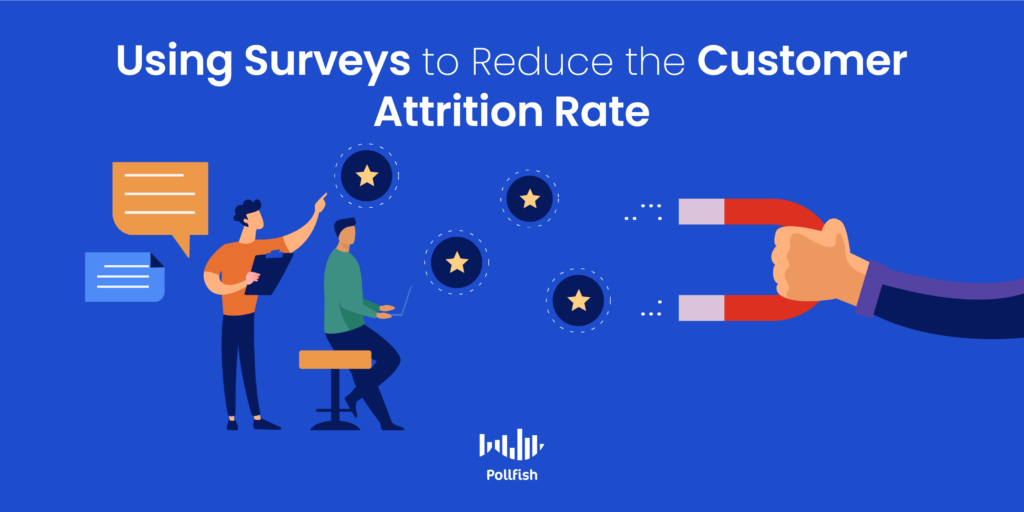
Survey research can go a long way towards reducing the customer attrition rate, as it brings businesses a wealth of customer intelligence. First off, surveys can identify dissatisfied or unhappy customers, along with those who seek better CX, more reasonably-priced products and much more.
As such, surveys provide businesses with a means of catching unhappy customers before they churn. The insights that businesses gain from these surveys allow them to take the appropriate actions to reverse customer dissatisfaction and fulfill their needs, desires and the like.
Surveys allow market researchers to deeply examine virtually any issue they choose. This makes it possible to understand customers at a granular level, as researchers can question them on specific topics.
Survey research also equips businesses with both quantitative and qualitative market research, providing a holistic market research approach for examining customers.
In terms of quantitative research, researchers can deploy thousands of surveys in just one round (depending on the online survey platform they use), granting them a means of statistical significance for quantitative data. They would need to set up multiple-choice questions to gain quantitative data.
As for reaping qualitative data, market researchers can create surveys with open-ended questions, allowing respondents to express their ideas, opinions, unique needs, aversions and more. This grants businesses a deeper understanding of their customers, allowing them to strategize accordingly to ward off customer churn.
As such, businesses can use surveys to fully understand their customers, cater to them aptly, reverse any negative feelings towards their company and much more. Essentially, surveys are customer intelligence powerhouses that make it quick and convenient to study customers, along with trends in an industry.
Keeping Churn at Bay
While customer attrition is inevitable, businesses can still keep a pulse on their customers to retain them, minimizing their customer turnover in the process. Surveys are the key tools for achieving this, as they allow businesses to probe deeply into the minds and habits of their target market.
With this in mind, businesses need to use a strong online survey platform to carry out successful survey campaigns. Such a platform should make it easy to hyper-target respondents, create and deploy surveys, extract the highest quality of data via artificial intelligence and machine learning, set quotas to fine-tune the respondent pool and use an intended sampling pool size and more.
A business that uses such an online survey platform is well-equipped to study its customers, along with their needs and dissatisfactions. This will enable them to make informed decisions that thwart their customers’ unhappiness and retain more of them. Thus, this kind of survey software has a direct effect on reducing the customer attrition rate.
Creating a Culture of Data Democratization with Polling Software
Creating a Culture of Data Democratization with Polling Software
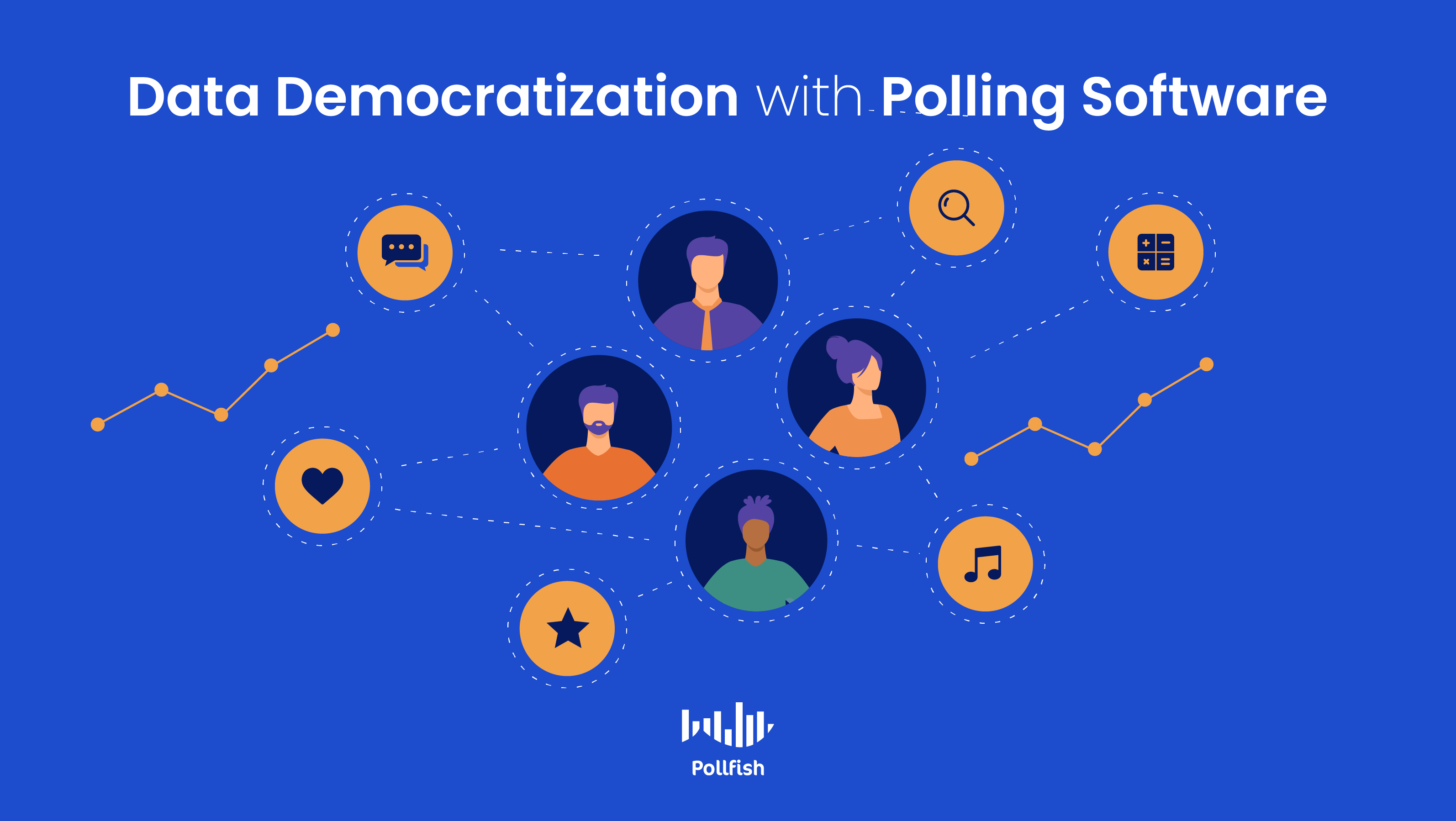
Data democratization is critical to sustain, especially for companies that heavily rely on using data for decision-making. This concept aligns team members with the critical insights that only data and other digital information can bring.
97% of business industry leaders agree that democratizing data across an organization is key to business success, and for good reason, given the growing need and prevalence of data within a business.
Prior to the democratization of data, IT teams would chiefly own and operate all the data that a company housed. As such, other departments and team members that required using data such as marketing, the executive team and even data analysts had to go through IT to access the data.
Data democratization changed all that rather recently, within the past decade, this is. With the abundance of data creation in companies and the emerging technologies that make data more accessible to the non-technical user, strides are being made for democratizing data.
This article explains data democratization, its importance, its challenges, how to foster it and how polling software can uphold this crucial practice.
Understanding Data Democratization
Data democratization refers to the practice and condition in which everybody in a company has access to data and an environment where there are no gatekeepers creating a bottleneck to the data.
It requires businesses to accompany easy data access with a means for all team members to understand the data, uncover its opportunities and make use of the data and its implications quickly.
The ultimate goal of democratizing data is to have anybody use it at any time to partake in decision-making without any barriers or limitations to access or comprehension.
However, simply granting data access — whether as raw data in a data warehouse or in the form of visualizations in a business intelligence or product analytics tool — does not constitute data democratization.
This is because data democratization involves a continuous process of enabling everybody in a business, regardless of how technically adept they are, to work with data without constraints. This involves creating an atmosphere of comfort to discuss the data and use it for a wide range of purposes.
When businesses achieve this kind of environment, their employees can make critical decisions that help the company improve on a variety of fronts, such as advertising campaigns and customer experience (CX).
The Importance of Data Democratization
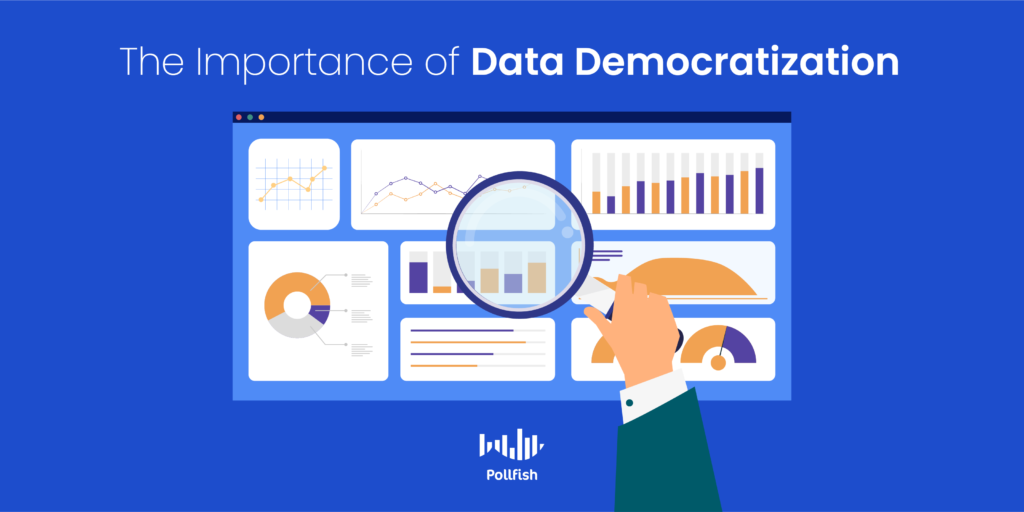
This concept is important in the modern day, given the overabundance of data that businesses extract, create and ultimately use to drive decision-making. The overwhelming amount of data is known as big data, and it creates bottlenecks across all departments that depend on it in the slightest.
Data democratization works to manage big data through processes and tools that rein in unstructured data and large amounts of it. In this way, democratizing data lessens the chaos of big data and makes it easier to both access and understand, so that it can be used immediately, whether for analyses or making decisions.
As such, data democratization quickens work that requires using big data, making business operations that depend on it run more efficiently.
Data democratization is also important in that it makes all team members more autonomous and therefore productive. This is because it allows non-technical end-users to comfortably assess the data in a digital format without soliciting help from IT.
In turn, this quickens operations and bolsters efficiency, as non-technical team members can use data without asking others for assistance and slowing down other operations.
Additionally, democratizing data gives businesses the advantage that data was originally meant to provide: that of a competitive edge. Given that data empowers businesses on a wide variety of matters, from web traffic, to their customer behavior, it ought to be understood by all team members.
Otherwise, they won’t be able to use it, whether it is purely for observations or for making recommendations and using it for non-IT purposes, such as content marketing strategy. When all team members can easily access and understand data, only then can the data in question provide a competitive edge.
Moreover, democratizing data allows companies to take part in transforming their organization, whether it is via fostering a digital transformation or a new structure within a department. This is because data can be used to unlock key findings, create new opportunities and help businesses execute changes, but this works optimally when every team member has easy access to the data.
The Challenges of Data Democratization
Supporting this concept comes with its own set of challenges. These challenges stem from two main sources: the liabilities, difficulties and business risks for the company itself and for those of the employees.
Regarding the former, this involves higher-ups and their concerns in terms of making data accessible to all. As for the latter, it deals with most of the other non-executive or IT employees and their challenges in sustaining data democratization.
Company/Higher-Up Data Challenges
- The expanding challenge of employees who know enough to be dangerous, misinterpreting the data and making bad decisions as a result.
- The risk of data silos when duplicate data is created in instances within groups across the business, which then necessitates duplicating data management efforts
- The possibility of losing data-related truths as a result of the silos.
- The risk of exposing businesses to ethical, legal and privacy concerns
- The challenge of designating the correct employees to parse through certain data types.
- The technical challenge of analyzing and managing data with a fitting tool.
- The challenge of creating processes across departments to work with data alongside their main objectives.
Employee Data Challenges
- The difficulty of not having access to the data employees need
- The challenge of trusting the data observed
- The challenge of lacking the skills to find answers to questions due to the lack of skills of working with data
- The difficulty of the tools a company provides that aren’t designed for certain teams
- The challenge of collaboration, where data experts at a company are too busy to help other employees
- The risk of making false assumptions after studying the data.
- The difficulty of using tools that claim to support the democratization of data
Fostering Data Democratization
Since sustaining this concept is multi-pronged in nature, businesses must consider the various factors that support it. Bearing these factors in mind, they must also be able to answer key considerations to build truly democratized processes.
Here are several key factors of sustaining data democratization:
- Businesses must remember that to gain a competitive advantage, they must use digital tools that support data democratization.
- These tools should be designed in a way that makes them easy to access, use and interpret by non-technical employees. They should be as user-friendly as possible.
- Companies should empower employees to feel comfortable asking any data-related questions, along with sharing any data-based information and ideas.
- Individual departments should encourage employees to use data, especially for departmental needs.
- This will give employees a purpose to use the data to begin with.
- Training on tools and analyzing data should be made available to employees.
- Organizations should consider taking part in a cultural shift so that working with data becomes a priority for all employees and for the democratization of data to become attainable.
How to Approach the Data Itself to Ensure Accessibility
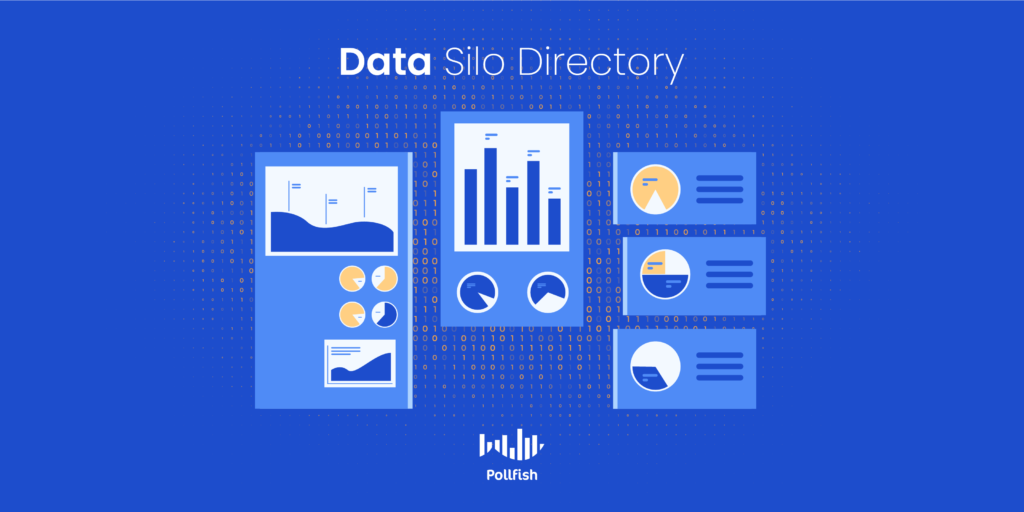
Aside from adhering to best practices that deal with employees to foster data democratization, businesses must also take heed of ensuring accessibility in the data itself. To do so, they must consider how they generate and operate their data.
The following lists the key data-specific considerations to take to ensure the democratization of data. Each step in this approach should be taken in relation to a business’s goals and data intent. This should be an evolving and iterative process.
- Data source mapping – Where is the data coming from?
- This first step involves using a map of data sources so that everyone can be aware of where the data comes from. This is crucial since not all sources provide the same kind of information and quality.
- Data accounting – What are we collecting?
- After you find the sources of data, you need to understand what’s coming from those sources. You should organize the data, as you’re bound to receive contact data, metrics, intelligence components and more.
- This helps you understand which data sources can benefit a business the most and which are best-suited for role-specific tasks.
- Data silo directory – Where is the data stored?
- This is especially important for data democratization, as employees need to know where data is stored in order to access it. Some companies extract and store all their data in one system, while others do so in multiple systems, especially when SaaS integrations are involved
- Data governance – How do you control it?
- Although you need to make data accessible to all, you have to consider data privacy, ethical and other risk-related considerations, especially when employees remotely access data with Personally Identifiable Information (PII), which may contain sensitive information.
- You need a data governance strategy to define how data is accessed and treated in the context of democratization. Consider who needs to see what data and what level of security, encryption and other actions are required given the nature of the data.
- Data Management – What maintains the data?
- Use data management frameworks, tools and processes to reach data governance objectives.
- These will help build mechanisms that achieve objectives within data transformation, quality, migration, privacy compliance and more.
- Middleware Strategy – How do you connect it?
- Create a middleware strategy to unify multi-sourced attributes.
- This may include building a master data warehouse connected to the systems and sources of data.
- Data Accessibility – How to expand ownership of the data?
- Provide non-technical workers and working groups the ability to interface with, and gain role-specific value from the data.
- This involves forgoing coding or using low code and NoSQL platforms to expand data ownership.
Using Polling Software for Democratizing Data
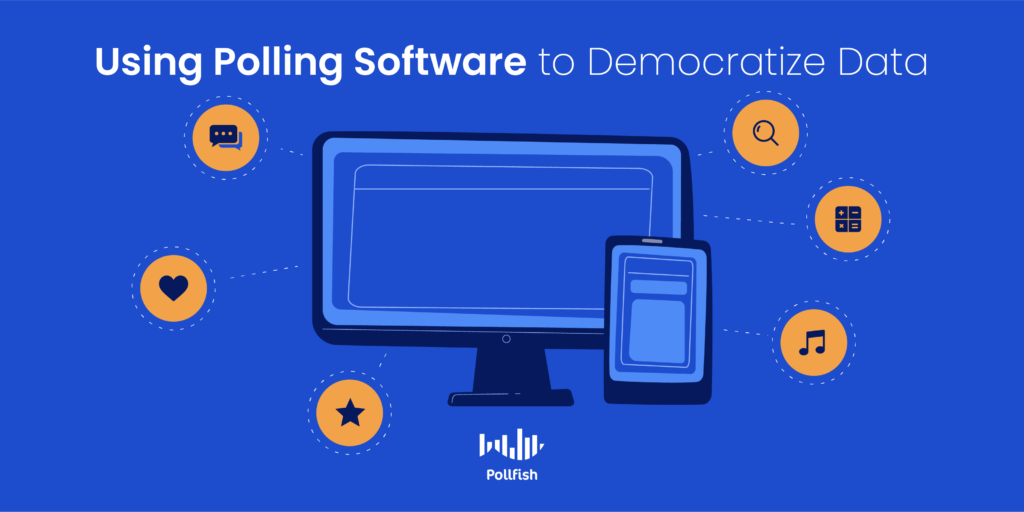
An organization that seeks to democratize data can benefit from polling software. This is the ideal source of data to use for a variety of market research endeavors, many of which drive marketing, advertising and various other business activities.
The right polling software makes it both practical and easy for all team members to create and deploy surveys. A democratized platform allows you to make your own survey in three easy steps, minimizing the downtime on any data-driven project.
Such a platform should allow for easy access by sharing results with shareable links, that is, links available to the public, aside to just certain users. It should also make it simple to filter all kinds of data — from the screener portion of a survey, to the questionnaire, to the post-survey dashboard.
Polling software can also create a culture of data democratization with simple visualizations, user-friendly navigation, different options for exporting and viewing the data — such as crosstabs — the ability to easily change the status of surveys and much more.
When a business uses polling software with these capabilities, it is on the right track to forming democratized data, as it is the ideal tool for it.
Gaining a Wide Breadth of Data
Polling software provides a vital tool for creating a culture of data democratization. However, not all polling software is built the same or offers the same capabilities. Some online survey platforms may be inept at providing democratized data to businesses, due to a lack of user-friendliness or democratization capabilities.
This is why companies should choose the polling software that is most apt for making data accessible and easy to use. A strong online survey platform should obtain high-quality data, which can be attained with the RDE (random device engagement) sampling method. This method engages customers in their natural digital environments in a completely randomized way.
Such a platform must also rely on artificial intelligence to perform quality checks that ensure that brands extract only the highest quality of customer data. These checks should disqualify VPN users, gibberish answers, incomplete surveys and other sources of poor data from appearing in the final survey results.
When a business uses such an online survey platform, it is prepared to generate a culture of data democratization, not to mention, a valuable market research campaign.
What is Experimental Research & How is it Significant for Your Business
What is Experimental Research & How is it Significant for Your Business
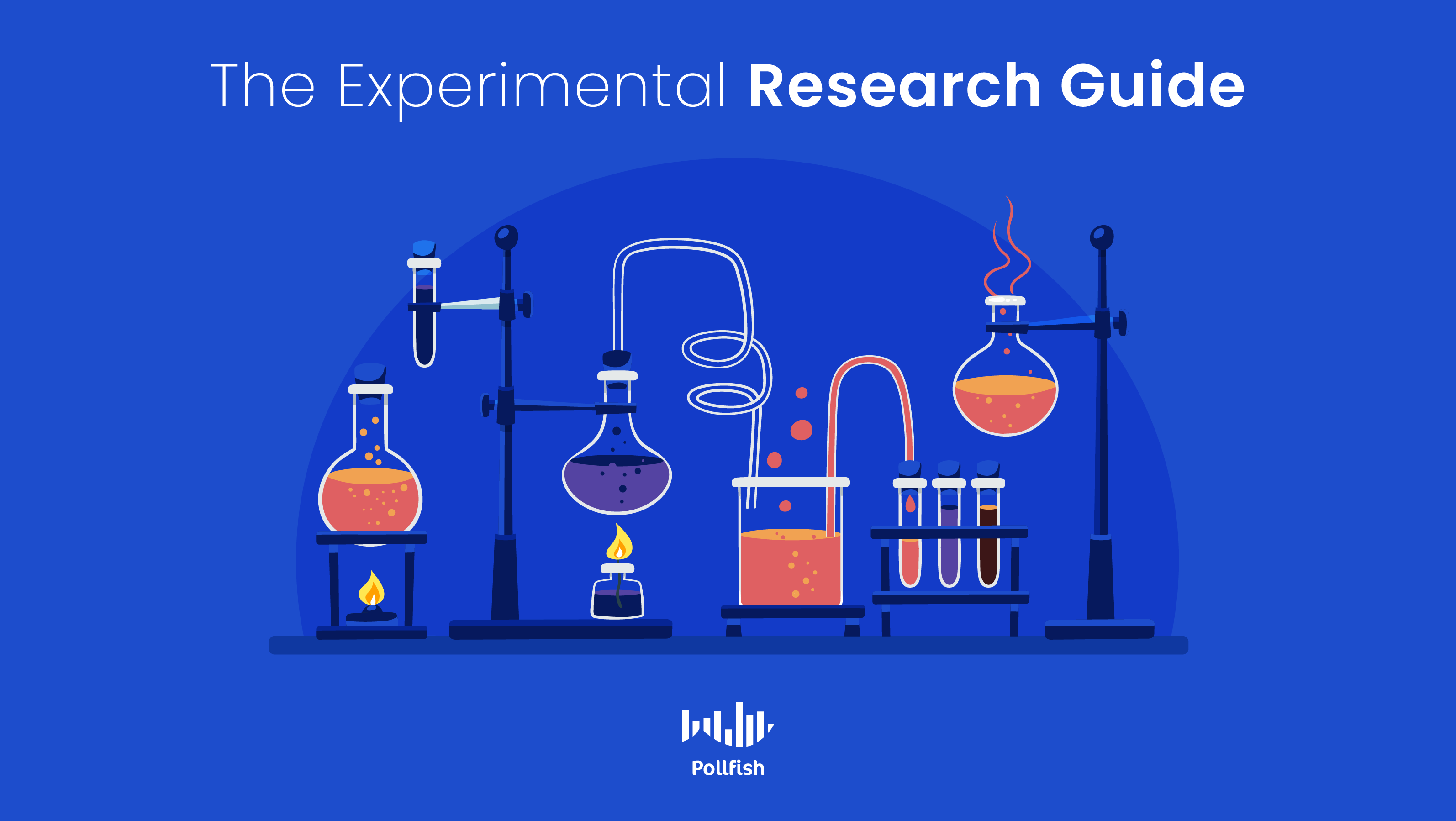
Experimental research uses a scientific method for conducting research, employing the most methodical research design. Known as the gold standard, it involves performing experiments to reach conclusions and can be conducted based on some of the findings from previous forms of research.
Logically, it would follow correlational research, which studies the relationships between variables. It can also follow causal research, a kind of experimental research in itself, as it establishes cause and effect relationships between previously studied variables.
Experimental research is typically used in psychology, physical and social sciences, along with education. However, it too can be applied to business.
This article expounds on experimental research, how it is conducted, how it differs from other forms of research, its key aspects and how survey studies can complement it.
Defining Experimental Research
Experimental research is a kind of study that rigidly follows a scientific research design. It involves testing or attempting to prove a hypothesis by way of experimentation. As such, it uses one or more independent variables, manipulating them and then using them on one or more dependent variables.
In this process, the researchers can measure the effect of the independent variable(s) on the dependent variable(s). This kind of study is performed over some time, so that researchers can form a corroborated conclusion about the two variables.
The experimental research design must be carried out in a controlled environment.
Throughout the experiment, the researcher collects data that can support or refute a hypothesis, thus, this research is also referred to as hypothesis testing or a deductive research method.
The Key Aspects of Experimental Research
There are various attributes that are formative of and unique to experimental research in addition to its main purpose. Understanding these is key to understanding this kind of research in-depth and what to expect when performing it.
The following enumerates the defining characteristics of this kind of research:
- It includes a hypothesis, a variable that will be manipulated by the researcher along with the variable that will be measured and compared.
- The data in this research must be able to be quantified.
- The observation of the subjects, however, must be executed qualitatively.
- It can be conducted in a laboratory in field settings, i.e., field research.
- The latter is rarer, as it is difficult to manipulate treatments and to control external occurrences in a live setting.
- It relies on making comparisons between two or more groups (the variables).
- Some variables are given an experimental stimulus called a treatment; this is the treatment group.
- The variables that do not receive a stimulus are known as the control group.
- First, researchers must consider how the variables are related and only afterward can they move on to making predictions that can be tested.
- Time is a crucial component when putting forth a cause-and-effect relationship.
- There 3 types of experimental research:
- Pre-experimental research design
- True experimental research design
- Quasi-experimental research design
The Three Types of Experimental Research
Experimental research encompasses three subtypes that researchers can implement. They all fall under experimental research, differing in how the subjects are classified. They can be classified based on their conditions or groups.
Pre-experimental research design:
This entails a group or several groups to be observed after factors of cause and effect are implemented.
- Researchers implement this research design when they need to learn whether further investigation is required for these particular groups.
- Pre-experimental research has its own three subtypes:
- One-shot Case Study Research Design
- One-group Pretest-posttest Research Design
- Static-group Comparison
Quasi-experimental Research Design
Representing half or pseudo, the moniker “quasi” is used to allude to resembling true experimental research, but not entirely.
- The participants are not randomly assigned, rather they are used when randomization is impossible or impractical.
- Quasi-experimental research is typically used in the education field.
- Examples include: the time series, no equivalent control group design, and the counterbalanced design.
True Experimental Research Design
This kind of experimental research design studies statistical analysis to confirm or debunk a hypothesis.
- It is regarded as the most accurate form of research.
- True experimental research can produce a cause-effect relationship within a group.
- This experiment requires the fulfillment of 3 components:
- A control group (unaltered) and an experimental group (to undergo changes in variables)
- Random distribution
- Variables can be manipulated
Why Your Business Needs Experimental Research

There are various benefits to conducting experimental research for businesses. Firstly, this form of research can help businesses test a new strategy before fully engaging in/ launching it.
The strategy can involve anything from content marketing strategy, to a new product launch. This is especially useful for technology companies, which conduct experimentation frequently. In fact, this kind of research is essential to an R & D (research and development) department.
This makes experimental research a much-needed effort when it comes to spurring innovation. Whether it involves a slight rebranding or an upgrade of products, experimental research guides these campaigns in a science-backed manner.
Secondly, a business must excel in meeting customer needs. Customer experience is an overwhelmingly important side of any business, as customers are willing to make on-the-stop purchases and pay more for a good CX.
As such, each product addition and change in a customer journey must be carried out wisely. Businesses ought to avoid creating unwanted services, or those that cause any aversion within customers. Instead, they should only invest in the most profitable services, products and experiences, a feat that cannot be accomplished solely on guesswork.
Experimenting allows brands to understand customer preferences and changes in their behaviors, as the experiments create stimuli and changes in independent variables.
Additionally, experimental research grants companions an understanding of their business environment. In turn, this helps them predict outcomes, or create hypotheses about outcomes to guide them in further research, if need be. For example, a business may consider testing the reactions of its competitors should it raise its costs on various offers.
Aside from discovering if this yields a profitable change, it can discover how companies in the same niche respond and if those responses drive more sales, etc.
Key Independent Variables
- Prices
- Digital user experience (DX) such as new site features
- Advertisements
- Marketing activity (SEO, SEM, social media announcements, retargeting, etc.)
- Season
- Inventory (new products or upgrades)
- Interactions with sales agents
Key Dependent variables
- Sales
- Demand
- VoC feedback (whether positive or negative)
- Site traffic
- In-store visits
- Revenue
- Time spent on a website, bounce rates, etc.
An Example of Experimental Research for Business
Market researchers can apply experimental research to a wide breadth of testing needs. Virtually anything that requires proof, confirmation, or is clouded by uncertainty can put experimentation into practice.
The following is an example of how a business can use this research:
A product manager needs to convince the higher-ups in a denim company to launch a new product line at a particular department store. The objective of this launch is to increase sales, expand the company’s floor presence and widen the offerings.
The manager has to prove that this line is needed in order for the company to pitch the idea to the department store. The product manager can then conduct experimental research to provide a strong case for their theory, that a new line can raise sales.
The product manager performs experimental research by executing a test in a few stores, in which the new line of denim is sold. These stores are varied in location to signify the target market sales before and after the launch. The test runs for a month to determine if the hypothesis (the new line resulting in increased attention and sales) can be proven.
This represents a field experiment. The product manager must heed the sales and foot traffic of the new product line, paying attention to spikes in revenue and overall sales to justify the new line.
Experimental Research Survey Examples
Survey research runs contrary to experimental research, unlike the other main forms of research such as exploratory, descriptive and correlational research. This is because the nature of surveys is observational, while experimental research, as its name signifies, relies on experimentations, that is testing out changes and studying the reactions to the changes.
Despite the contrast of survey research to experimental research, they are not completely at odds. In fact, surveys are a potent method to gain further insight into an existing experiment or understand variables before conducting an experiment in the first place.
As such, businesses can adopt a wide variety of surveys (using market research) to complement their experimental research. Here are some of the key forms of surveys that work in tandem with experimentation:
- The quantitative survey
- Discovers the aspects of statistical significance within variables.
- Helpful in that causal research is quantitative in essence.
- The retrospective survey
- Delves into past events, occurrences and attitudes in regards to the variables.
- Shows whether the variables changed and how so.
- The prospective survey
- Can find causative elements between variables over a period of time.
- Useful for formulating hypotheses.
- The customer experience survey
- Helps businesses zero in on variables that contribute to or result from certain kinds of customer experiences.
- Allows businesses to test CX in relation to the responses from this survey.
- The pulse survey
- Measures various matters critical in a business or organization; surveys employees.
- Deployed more frequently, so variables can always be continually tracked.
- The qualitative survey
- Helps answer the what, why and how with open-ended questions.
- Extracts key high-level information in depth.
How Experimental Research Differs from Correlational, Exploratory, Descriptive and Causal Research
Experimental research differs from exploratory, descriptive and correlational research in self-evident ways. It is, however, often conflated with causal research. However, they too have notable differences.
Causal research involves finding the cause-and-effect relationships between variables. Thus, it too employs experimentation. However, this means that causal research is a form of experimental research, not the other way around.
Experimental research, on the other hand, is fully science and experiment-based, as it chiefly seeks to prove or disprove a hypothesis. While this largely involves studying independent and dependent variables, as it does in causal research, it is not solely based on these aspects. Instead, it can introduce a new variable without knowing the dependent variable or experiment on an entirely new idea (as in the example used in the previous selection).
Causal research looks into the comparison of variable relationships to find a cause and effect, while experimental research states an expected relationship between variables and is bent on testing a hypothesis.
As far as comparisons to correlational research go, while experimental research also studies the relationships between variables, it functions far beyond this by manipulating the variables and virtually all subjects involved in experiments.
On the contrary, correlational research does not apply any alterations or conditioning to variables. Instead, it is a purely observational research method. As such, it merely detects whether there is a correlation between only 2 variables. In contrast, experimental research studies and experiments with several at a time.
Exploratory research is vastly different from experimental research, as it forms the very foundation of a research problem and establishes a hypothesis for further research. As such, it is conducted as the very first kind of research around a new topic and does not fixate on variables.
Descriptive research, like exploratory research and unlike experimental research, is conducted early in the full research process, following exploratory research. Like exploratory research, it seeks to paint a picture of a problem or phenomenon, as it zeros in an already-established issue and delves further, in pursuit of all the details and conditions surrounding it.
Thus, unlike experimental research, it only observes; it does not manipulate variables in any capacity or setting.
The Advantages and Disadvantages of Experimental Research
Experimental research offers several benefits for researchers and businesses. However, as with all other research methods, it too carries a few disadvantages that researchers should be aware of.
The Advantages
- Researchers have a full level of control in an experiment.
- It can be used in a wide variety of fields and verticals.
- The results are specific and conclusive.
- The results allow researchers to apply their findings to similar phenomena or contexts.
- It can determine the validity of a hypothesis, or disprove one.
- Researchers can manipulate variables and use them in as many variations as they desire without tarnishing the validity of the research.
- It discovers the cause and effect among variables.
- Researchers can further analyze relationships through testing.
- It helps researchers understand a specific environment fully.
- The studies can be replicated so that the researchers can repeat their experiments to test other variables or confirm the results again.
The Disadvantages
- It involves a lot of resources, time and money, as such, it is not easy to conduct.
- It can form artificial environments when researchers unwittingly over-manipulate variables as a means of duplicating real-world instances.
- It is vulnerable to flaws in the methodology, along with other mistakes that can’t always be predicted.
- Flawed experiments may require researchers to start their experiments anew to avoid false calculations, measuring results from artificial scenarios or other mistakes.
- Some variables cannot be manipulated and some forms of research experiments are too impractical to conduct.
How to Conduct Experimental Research

Experimental research is often the final form of research conducted in the research process and is considered conclusive research. The following explains the general steps required to successfully complete experimental research.
- Identify your research subject, a question surrounding it and its variables.
- Form a specific research question.
- Gather all available literature and other resources around the subject.
- Conduct secondary research around the subject and primary research via surveys.
- If the topic involves a research process you have already begun, for instance in exploratory, descriptive, correlational or causal research type, gather together the facts you already have and hand.
- Consider how they relate to your question and how they line up with the secondary research you conducted.
- After your initial studies, form a hypothesis.
- Design a controlled experiment.
- First, decide which variable(s) is dependent/ independent (if it doesn’t involve experimenting).
- Decide how far to vary the independent variable.
- In the experiment, manipulate the independent variable(s).
- Measure the dependent variable(s) while you study the independent variable(s) alongside.
- Make sure to control potential confounding variables.
- Assign subjects to their designated experimental treatment groups.
- Keep the study size in mind; a larger study pool creates statistical findings.
- Assign your subjects to “treatment” groups randomly, with each to receive a different level of “treatment.”
- Use a control group, which receives no manipulation. This shows you the test subjects as they appear/behave without any experimental intervention.
- There are 2 types of groups for assigning your subjects:
- A completely randomized design vs a randomized block design.
- Completely randomized design: every subject gets randomly assigned to a treatment.
- Randomized block design: aka stratified random design, subjects get first grouped based on a shared characteristic, then assigned to treatments within their groups at random.
- An independent measures design vs a repeated measures design.
- Independent measure: subjects receive only one of the possible levels of an experimental treatment.
- Repeated measures design: every subject gets each of the experimental treatments consecutively, as their responses are measured. It also refers to measuring the effect of an emerging effect over time.
- A completely randomized design vs a randomized block design.
- Continue experimenting on variables as needed, take measurements and take notes.
- Based on your experiment(s), put together a logical conclusion. It is possible that it may need testing over time.
- Identify your research subject, a question surrounding it and its variables.
Using Experimental Research and Going Further
Although experimental research can be very complex, this research method is the most conclusive. Using a scientific approach, it can help you form tests on various business matters. While it is critical for understanding your target market’s and customers’ existing behaviors, it can also be used to experiment on a wide variety of other matters.
Before launching a new product, or an updated one, for example, you can conduct an experiment to understand the product in action. This helps you avoid any glitches or undesirable qualities that will incur problems for your customs and a bad reputation for your brand.
Experimental research is not for every business, yet if you decide to implement this form of research, consider using surveys in tandem. An online survey platform can help you establish and distribute your surveys to a wide network via organic sampling to avoid biases.
Although it isn’t a requirement, in today’s age of excelling in customer experience (CX), it is of the essence to have as much data on your target market as possible. The best survey tools for market research make this possible and they can help you quickly get high quality survey responses.
Understanding Customer Behavior with Market Research
Understanding Customer Behavior with Market Research

Customer behavior is one of the foremost areas of concentration in marketing, as consumers are the bedrock of a company’s success.
Businesses must therefore understand their customer behaviors in order to suit their needs and drive revenue. In fact, 66% of customers expect businesses to understand their needs and expectations.
But there is far much more to customer behavior than customer desires and expectations. This concept encompasses several facets of customer actions, along with the driving force behind them.
This article explores customer behavior, its importance, aspects and how a well-established campaign of market research techniques allows businesses to be well-acquainted with the customer behavior within their target market.
Defining Customer Behavior
Also called consumer behavior, customer behavior denotes the study of customers, particularly those in a target market, including the processes they use to choose, consume and discard products and services.
This field of study involves recording and examining customers’ mental, behavioral and emotional responses. Observing customer behavior goes beyond studying behaviors in a customer journey, that is, the actions customers take prior to making a purchase.
Rather, consumer behavior studies how customers choose products, why they avoid certain products, their buying behaviors, along with how they interact with a product or service. Thus, this concept transcends looking into what customers want and don’t want.
When studying these behaviors, researchers often incorporate scientific approaches, using notions from psychology and economics and even chemistry and biology.
Studying customer behavior can also involve studying organizations, especially for B2B businesses. However, B2C businesses can also stand to scrutinize companies as a kind of competitive analysis.
Consumer behavior is the study of individuals and organizations and how they select and use products and services. It is mainly concerned with psychology, motivations, and behavior.
The Key Aspects that Customer Behavior Investigates
As aforementioned, customer behavior takes various elements of customers into account, going beyond its subsets of customer journeys and customer buying behavior, which themselves span different concepts.
The following enumerates several key aspects that customer behavior encompasses.
- Buying habits, including locations, devices and frequencies
- Social trends and background factors that influence customers to make or avoid purchases
- Customer sentiment around product/service alternatives, such as related products/services, those from different brands
- Preferred methods of purchasing such as in-store versus online or both, at a large retailer or at a mom-and-pop shop, etc.
- Behaviors of customers as thy shop
- How customers search for companies
- How customers find businesses during their research
- Customer reasoning behind different alternatives
- How customers are influenced by their environments such as their friends, media, culture and other target market members
- How marketing campaigns influence or affect their behaviors
The Importance of Examining Customer Behavior
Studying this concept may appear to be laborious at worst and tedious at best, however, brands ought to avoid omitting it. This is because the aspects of customer behavior paint a critical picture of who customers are, allowing businesses to market and cater to them accordingly.
Understanding the customer behavior of customers allows companies to adapt and improve their marketing campaigns, sales promotions, customer service and more. Most importantly, it allows brands to influence their customers more productively.
Additionally, by understanding how customers choose, consume and discard products, businesses can identify issues in the products themselves and make innovations. In this way, studying customer behavior helps with product-related issues such as customer development and product satisfaction.
Businesses can therefore study it to find gaps and flaws in existing products and improve upon them. Or, they can create products with alternative features and even new products to gain a competitive advantage.
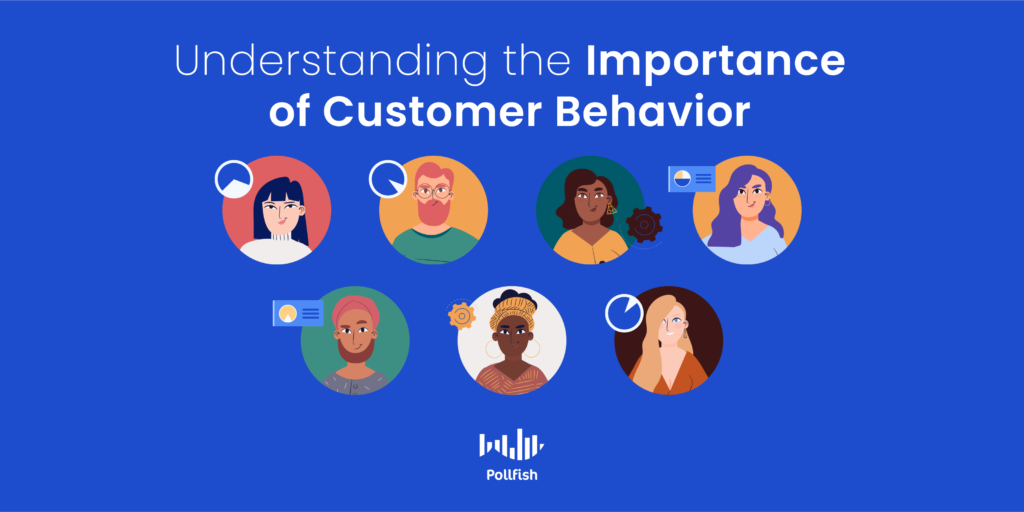
Studying consumer behavior also allows marketers to present their products more effectively, so that they can drive a maximum impact. That way, customers will be more keen on interacting with a business, whether they’ve long known about it or recently discovered it.
When customers engage with a business more frequently, they become far more exposed to marketing and advertising messages that can influence them to make purchases. In this way, engaging with a company, whether it is viewing their content or browsing their offerings lodges that company in customers’ minds, which is key for brand awareness.
Generally speaking, it is also ideal for customers to have businesses on their minds subconsciously. In fact, a Harvard Business School professor declares that 95% of purchases are made subconsciously in his book, How Customers Think: Essential Insights into the Mind of the Market. This book also discovered that the biggest drivers of unconscious urges are emotions.
All in all, examining consumer behavior enables businesses to become more attuned to their customers, thereby allowing them to better tailor their marketing efforts and retain customers for the long term.
Customer Behavior Patterns
It is important to identify the patterns that makeup customer behavior. Patterns are not to be confused with buying habits, as the latter refers to inclinations for an action that can become spontaneous, whereas patterns exhibit predictable occurrences.
Customer behavior patterns are also contrary to buying habits in that patterns are indicative of groups, while habits are more unique and individual-based.
The following explains the four customer behavior patterns:
- Items purchased: Businesses should study their customers’ shopping carts, as they reveal exactly what customers buy and how much of it they buy. Patterns usually show that customers buy everyday-use items in larger quantities and more frequently, while luxury items are bought less frequently and in smaller quantities.
- Customers tend to buy products based on the products’ perishability, a unit of sale, price, number of users of the product and the buying power of the customer.
- Place of Purchase: Customers usually shop at various stores, even when all of their intended products are available at just one. This largely depends on the accessibility of getting to various stores. When customers are not restricted to just one store due to transportation limitations, they are at liberty to choose items from multiple locations.
- Businesses must study place of purchase patterns, in that it will reveal customers’ choice of place, helping marketers understand which areas their customers visit.
- Purchase Method: The way a customer chooses to buy products divulges the kind of customer that they are. That is because there are various purchase methods, all of which tie into a customer journey.
- Customers can window shop online, then make up their minds at home and buy a product online. Or, they may buy a product in-store, via different payment options such as cash, debit or credit card.
- Businesses that gain this kind of insight into behavior patterns help them find ways to make customers buy again and more frequently.
- This pattern can also help businesses upsell products.
- Frequency and Timing of Purchase: Customers exhibit different times and frequencies of purchase. Regarding the former, they won’t all buy during business hours, given the prevalence of e-commerce, which allows them to shop at the earliest and latest parts of the day.
- Businesses can meet customer demands by studying their purchase timing and frequency in order to serve them better.
- Studying these concepts will help businesses adapt to regional (and global) time differences, along with seasonal variations.
The Things That Affect Customer Behavior
There are various influences and facets that can affect how customers behave. Businesses ought to acclimate themselves with these customer behavior factors, in that they all have a bearing on customer behavior and behavior patterns in one way or another.
When studying customer behavior based on these factors, businesses will be able to understand it more holistically. This helps in market segmentation and building customer personas, two market research tactics that allow businesses to gain a deeper understanding of their target market.

The following lists the critical factors of customer behavior:
- Purchasing power: even the wealthiest of customers are constrained to some sort of budget or need to buy things within their means. Thus, much of what customers buy depends on their purchasing power.
- Marketing campaigns: Specifically designed to persuade customers as well as reel in new ones, marketing campaigns have the capability to influence buying behaviors, when done correctly. They can prompt customers to switch brands or opt for a more expensive product with the correct messaging — which requires understanding your customers.
- Personality traits: Personality affects many kinds of behavior, including customer behavior. These spring from background and upbringing, which affect how people will behave in different settings. Some customers will be drawn to events (grand openings, sales, etc.) due to extroversion, while others may not be and some may fall in between.
- Personal preferences: The way customers choose purchases often relies on their personal preferences. Advertising and marketing campaigns can surely affect these but some preferences are unyielding. For example, a vegan will not buy animal-based products, while a meat lover is not going to shop for exclusively vegan items. Businesses should therefore be well-acquainted with the preferences of their target market.
- The economy: Economic conditions play a role in customer behavior, especially in relation to more expensive products; positive economic environments are bent on making customers more willing to indulge. In times of inflation, consumers are less likely to spend on expensive items, as well as make frequent purchases. Negative economic conditions are fruitful for businesses to introduce promotions and bargains.
- Group influence: Peer pressure and the opinions of others can also weigh heavily on buying and usage decisions. When customers’ friends and peers speak negatively or positively about an item or brand, it affects the way the customers perceive it. In some cases, group influence provides a setting of brand advocacy, while at other times, it can cause major reputational damage to a business.
- Social trends: Related to group influence, social trends set the scene in terms of what is popular and acceptable. From social media, to movies, blogs and podcasts, various talking points and fads can form and leave strong impressions among customers. Some of these platforms provide a breeding ground for new trends, the kinds that marketers can access, depending on their budget and strategy.
How Market Research Helps Businesses Understand Customer Behavior
Conducting market research enables businesses to understand all the key facets of customer behavior. There is much involved in market research, all of which can help marketers deliver more effective campaigns.
First off, market research encompasses a wide breadth of studies, from secondary research to primary research and from quantitative research to qualitative research. There is a vast pool of available resources, i.e., secondary sources available. These can take the form of industry news sites, statistics sources, published studies and more.
While secondary research is an important starting point for conducting market research, it does not address all the specific needs that a business may have, let alone the specific questions that businesses intend to probe their customers with.
As such, all businesses should turn to primary sources to understand their consumer behaviors. There are different routes for market researchers to take on this front; effective survey studies are the most useful. This is because surveys allow researchers to understand where their target market lies in all the factors and patterns of customer behavior.
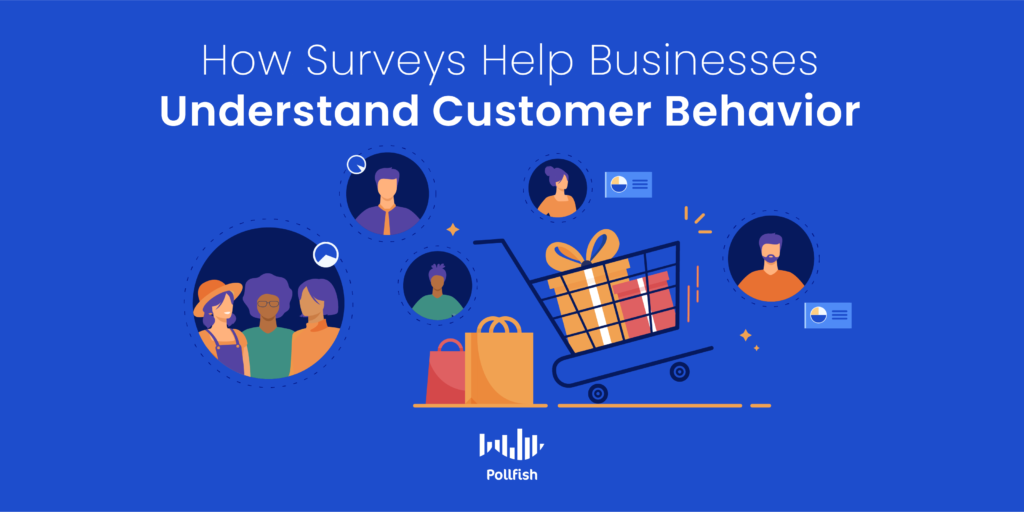
For example, market researchers can conduct surveys to learn more about their customers’ purchasing power and how it relates to what they buy and how much. In addition, they can qualify only certain people from taking a survey, so that they can study respondents who fall within a particular income bracket.
Another example involves surveying customers based on their awareness levels of cultural trends and their opinions thereof.
In relation to studying customer buying patterns, surveys provide value, in that customers can ask detailed questions about all patterns, whether they are concerned with purchasing methods, the place of purchase, frequency, etc.
A strong online survey platform will allow businesses to gain a deep understanding of these aspects, through the use of advanced skip logic, which routes survey respondents to appropriate follow-up questions based on their answers to previous questions.
Finally, surveys allow market researchers to make decisions in an organized way, as they help form a customer behavior analysis report. This report reveals:
- How customers behave while researching, browsing products and purchasing
- How customers use products
- How long customers use their products
- What customers think and feel about different brands and product options
- How their environments affect their behavior
Improving Business Goals and Scaling by Understanding Your Target Market
Customer behavior to a business is like blood to mammals. While this may sound dramatic, it analogizes the importance of understanding your target market’s behavior. When businesses fail to study their customers’ behaviors, they are remiss on so many meaningful opportunities.
Thus, marketing campaigns of all sizes and calibers are at a much larger risk of failing. Market research, particularly survey research helps combat ignorance of customer behavior. This is because surveys give researchers the freedom to study any factor and pattern that relates to this behavior, arming them with critical insights on how customers shop throughout their journeys.
The most crucial component of survey research is using the correct online survey platform. Not all surveys offer advanced skip logic and can qualify respondents based on various demographics and psychographics. Thus, businesses and market researchers must invest in an online survey tool wisely, as it can make or break any market research campaign.
Diving Into the Net Profit Loss and How Market Research Helps Avoid It
Diving Into the Net Profit Loss and How Market Research Helps Avoid It
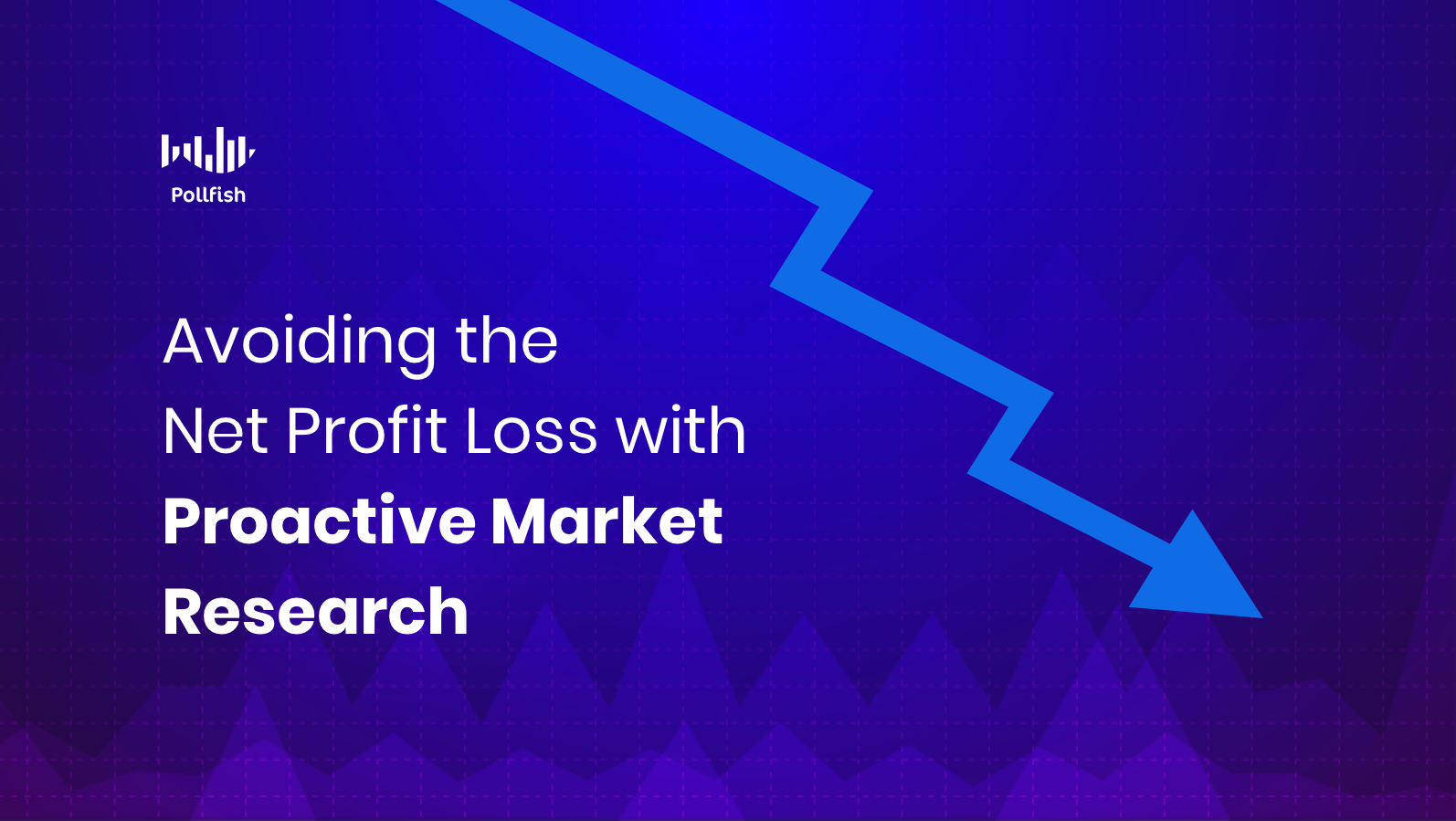
It is in the best interest of businesses that seek to stay afloat to circumvent the net profit loss. An accounting term, net profit loss is a critical issue that businesses and market researchers must pay close attention to and endeavor against.
This term relates to profits, namely the lack of profits, when business expenses surpass revenue. As such, it represents a negative value for a company’s income. This value is recorded in the net income portion situated at the bottom of a business’s income statement, also called the profit and loss report.
Given the unpredictability of markets and events, take the COVID-19 crisis for instance, all businesses should be wary that they too may incur a net loss at any given time.
While there are mechanisms that help companies stay in business in spite of sustaining a net loss, they will not help a company survive in the long-term, as net profit loss is one of the main drivers of business failure.
This market research guide expounds on the net profit loss, including its causes and solutions, how to calculate it and more, along with how survey research can help businesses avoid it.
Understanding Net Profit Loss
This concept has several names, such as net loss and net operating loss, all of which refer to the negative value in income, which occurs when business expenses exceed the total income or total revenue during a specific period of time.
Thus, net loss refers to the negative consequence of businesses losing money, given that expenses do not merely carry the same costs as the total revenue, but exceed it.
Net loss is the opposite of net income, which refers to the case of income or revenue exceeding expenses, therefore producing a profit. Net income is also referred to as a net gain.
Business owners can check whether they have induced a net loss in their company’s income statement, which is also referred to as a Profit and Loss (P&L) Report. The net loss or net income appears at the bottom of this report, which is how business earnings gained their moniker of the bottom line.
This net loss issue is one of the chief risks that both startups and long-established businesses face. When left unaddressed and neglected, this problem can cause a company to permanently go out of business. This is because the lack of profits causes major financial damage that leads to bankruptcy.
Businesses can prevent going bankrupt should they take loans or use their retained earnings. However, these strategies are merely short-term safety nets; they cannot sustain a business in the long-term.
Therefore, this concern should not be solely left up to accountants to view and report, as all businesses must strive to steer clear of net profit loss.
The Causes and Solutions of Net Profit Loss
There are several contributing factors of net operating loss. Therefore, a business should examine all of these factors in relation to itself to determine which cause contributes the biggest dent to profit.
First off, low revenues are the greatest cause of net profit loss, which themselves include several factors. Low revenues can be the end result of an economic recession. For example, the COVID-19 pandemic caused major economic devastation in the US, in which 50% of people aged 25 to 44 lost their jobs, thus losing their spending power.
Other causes of low revenues include a strong competitive presence, poorly performing marketing initiatives, insufficient sales processes, low product demand, prices that don’t match the target market’s spending power and many other considerations.
Rising expenses are another cause and these can include anything required to maintain the business, from business headquarter costs, to marketing, to customer acquisition cost (CAC), to SaaS and marketing investments, to the cost of goods sold (COGS). COGS include all the costs required to produce the goods that companies sell and bring them to market.
Net loss also comes into being when a business’s products are low on demand. This can occur when products become obsolete or when a competitor offers either a more advanced version or a better quality or of the products. Thus, when product performance is insufficient, the demand for it drops, along with its sales.
Another cause of profit losses is that of poor management execution, which can occur in a number of disciplines, such as product, marketing, sales, customer support and others. For example, the product team may undergo delays. Or the marketing team may have run a poor campaign, one that draws little attention and leads.
A lack of brand tracking can additionally cause negative income statements since they can take a toll on a brand’s reputation. Companies that receive bad press, negative reviews or social media comments can sway the minds of even the most loyal of customers. This also ties into the idea of low product demand, as businesses who tout their products with heavy PR pushes can form a better public opinion of their products, thus pushing a business’s customers towards their competitors.
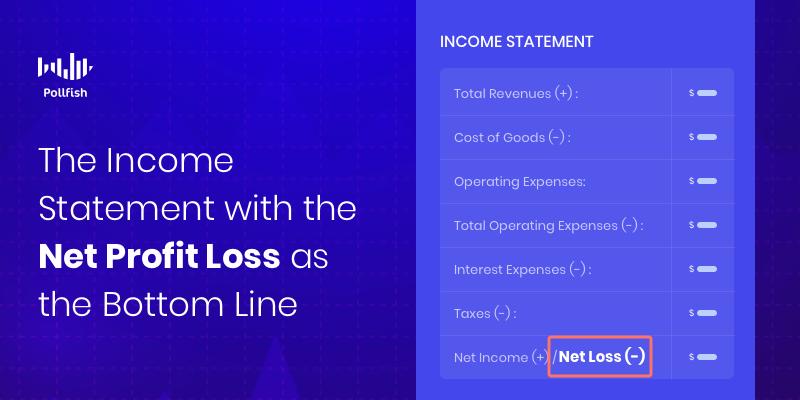
Finally, there is the receiving end of all marketing, sales and product efforts: the customers. Businesses can endure net loss when they do not have enough customers. This is typically a concern for new businesses along with those with scant brand equity. Brands with familiar names tend to reel greater customer loyalty and trust. However, even long-established brands can lose customers from a variety of factors, such as brand crisis, stiff competition or when businesses do not study their customers.
Businesses can avoid net profit loss in a number of practical ways. The following list enumerates several useful solutions to eliminate incurring profit losses.
- Businesses ought to create a fleshed-out budget and check it regularly in order to assure that all items continue to fulfill the budget.
- Businesses should remove expenses that no longer fit the budget such as martech and all other expenses, including business real estate costs.
- Marketers should execute quarterly campaigns set to increase sales, along with the sales team, which requires open communication and continuous collaborations.
- Brands should make reducing expenses one of their priorities. For example, rather than opening a new position, they should consider hiring a freelancer instead.
- Businesses should use the professional advice of accountants and advisors to ensure all operations can run smoothly without overspending the budget.
- Cutting down on store inventory and excess expenses is crucial. Businesses must first analyze their sales figures relative to their inventory. If there is a low demand for certain products, businesses should reduce manufacturing on them, as this will cut costs.
- Excess expenses also include administrative costs, office materials, labor costs and more.
How to Calculate Net Profit Loss
Calculating this metric is relatively simple. Its formula involves the same mathematical action as does the net income formula.
The formula for calculating net loss is to simply subtract all business expenses from the total revenue in a given period of time. This period can be quarterly, annual or centered on a specific campaign.
The following guide explains this formula in a step-by-step fashion:
- Calculate the total revenue your business generates from the resources it uses and their corresponding expenses.
- Net income and net loss are on the bottom line, while revenue is the top line in a P&L report or income statement.
- Layout all of your expenses in a particular time period. Add them all together.
- Finally, plug your values into the formula: (total revenue during X period) — (total expenses) = Net Profit Loss
Understanding a Profit and Loss Report
The profit and loss (P&L) report alludes to a report with a summary of all the income and expenses that a business retains and carries during a specific period of time. Also called the income statement, it lays out business losses relative to revenue.
This income statement can be formed on a weekly, monthly, quarterly or annual basis, depending on business procedure and formalities.
In this document, businesses are able to see whether they generated a net income, also called a net gain, or a net loss. It also shows a breakdown of all expenses, sales and revenue figures, so that businesses can see all the financial activity that they undergo.
A detailed ledger, the P&L report shows the ability of a business to manage its profits by reducing costs and driving revenue. It also allows businesses to examine cash flow, expense trends and general profitability so that they can informatively set up and tinker budgets, as well as allocate funds.
 Examples of Net Profit Loss
Examples of Net Profit Loss
The following provides several scenarios in which a business undergoes a profit loss.
Example 1
A business with an annual income of $100,000 incurs $120,000 in expenses related to running the business. This company has incurred a net loss of $20,000 for this year.
Example 2
A business acquires its competitor for $1 million. It generates a revenue of about $700,000 in this time period. It’s profit loss results in $300,000. However, it uses $300,000 in retained earnings to cancel out this loss.
Example 3
A local government overestimates the tax revenue by $150,000. In addition, it has road maintenance expenses that cost over $10,000 the funds it has due to snowy weather. Thus, its net loss is $160,000.
How Market Research Helps Avoid Net Profit Loss
Market research can help businesses avoid a net profit loss for any given period when conducted regularly and with the correct tools. There are various market research techniques, all of which provide key intelligence on a business’s overall niche, industry, competitors and target market.
Businesses can rely on both secondary and primary sources to have a better understanding of the trends within their niche, the demands of their industry and customers, their own standing and reputation and much more. This allows companies to create and execute well-informed business strategies and campaigns.
Most importantly, market research allows businesses to understand their customers, enabling them to better serve them. In this way, they can improve the reputation of their business, generate demand and increase revenue. This is because market research offers a vast pool of resources in order for businesses to acquaint themselves with their target market.
Survey research in particular offers the most potent form of market research, as it allows businesses to obtain their particular customer intelligence needs. Since it is a form of primary research, businesses gain the most updated information, whereas secondary sources may be months and even years old.
That is because even some of the most trusted sources of industry news and statistics recycle older information by merely updating a sentence on published articles, downloadable assets and resources. Sometimes, the only update they make to their sources is changing the date on old information to improve their natural ranking on search engines (a common SEO trick).
Additionally, secondary sources do not provide the unique insights brands need and specific inquiries they come across. They may also target segments of a target market that do not apply to a particular business.
Surveys, on the other hand, bypass both of these issues. They allow businesses to conduct campaigns suited precisely to their specific needs. Businesses can create a multitude of question types and ask questions on any topic of their choice. They can also target their specific target market segments if they use an online survey platform that allows for it.
Thus, surveys offer insights into all a business’s inquiries, allowing it to conduct valuable market research, understand the needs of its customers and avoid allocating funds on useless and inauspicious campaigns.
Reaching Profit Goals
The net profit loss is a somber reality for many businesses with insufficient customer intelligence. Market research is the antidote and surveys in particular can help businesses avoid profit losses by helping them focus on the needs, desires and aversions of customers.
This way, they can avoid unnecessary expenditures, save money and avoid overspending.
Survey research provides the most granular insights, as businesses can set their surveys up as they please. However, not all online survey platforms are equal in their functionality, capabilities, support and quality of data.
Thus, businesses ought to opt for a strong online survey platform, the kind that offers proven relentless quality, artificial intelligence and machine learning, a system that wards off low-quality answers and survey fraud, includes ease of use and deploys surveys across a wide network of publisher sites and apps via random device engagement.
The survey software that offers these functionalities and features will set up any survey campaign for success, bringing insights on a number of fronts, the kind that will effectively avoid the net profit loss.
How to Identify and Build Customer Personas with Market Research
How to Identify and Build Customer Personas with Market Research
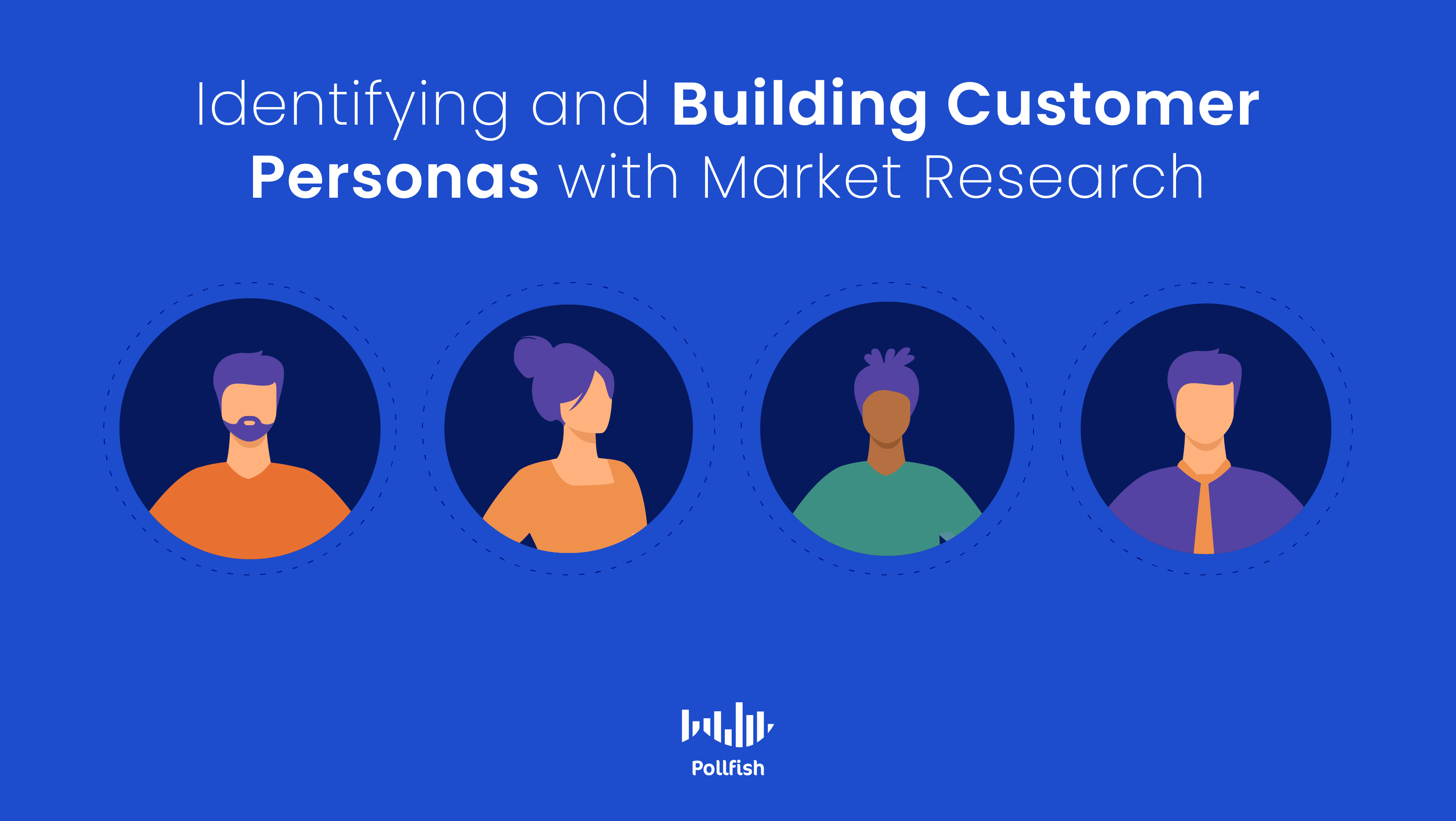
It is critical for businesses to be able to identify and cater to their customer personas, as these entities are not the same across businesses, regardless if the businesses share the same industry or niche.
Customer personas place a business’s customers into specific, collective archetypes, the kinds that help avoid targeting the wrong people in marketing campaigns. But customer personas can help b businesses achieve much more than identifying and targeting the correct consumers.
As a matter of fact, 93% of businesses that exceed lead and revenue goals segment their target market by customer personas. 56% of companies developed higher quality leads by using personas.
This market research guide explores the notions behind customer personas, their importance and how market research — particularly surveys — help businesses identify and construct their consumer personas.
Understanding Customer Personas
Also called buyer personas, marketing personas and audience personas, customer personas are a form of customer segmentation, but a far more granular subset, as they represent individual people.
A customer persona is a detailed description of a member in a business’s target market, i..e, the group of people most likely to buy from them. This persona is not a real customer, but a fictional character who possesses all the traits of a target market segment.
Building these personas is the more concentrated practice of market segmentation — the process of categorizing a target market into smaller, more defined customer segments. However, customer personas are not the same as customer segments.

Customer segmentation refers to dividing a target market into different sets of customers. These sets inform on a group’s demographics, geographical location and some aspects of their customer buying behavior. Segments help businesses understand the makeup of their target market as different sets of groups.
On the contrary, a customer persona refers to defining individual customers within the segments discovered during customer segmentation. Customers are assigned fictional characters that represent a typical customer in a market segment; they are assigned a granular depiction, one that includes various specifications for each persona.
After establishing a few customer personas, a business can then categorize its leads, prospects and customers into particular customer personas. This is especially useful for businesses with hundreds or thousands of clients and prospects.
The Key Aspects of Customer Personas
A buyer persona is formed as a profile of a customer, therefore including demographic and psychographic traits, along with other detailed characteristics. This includes their values, behaviors, goals and other defined categories.
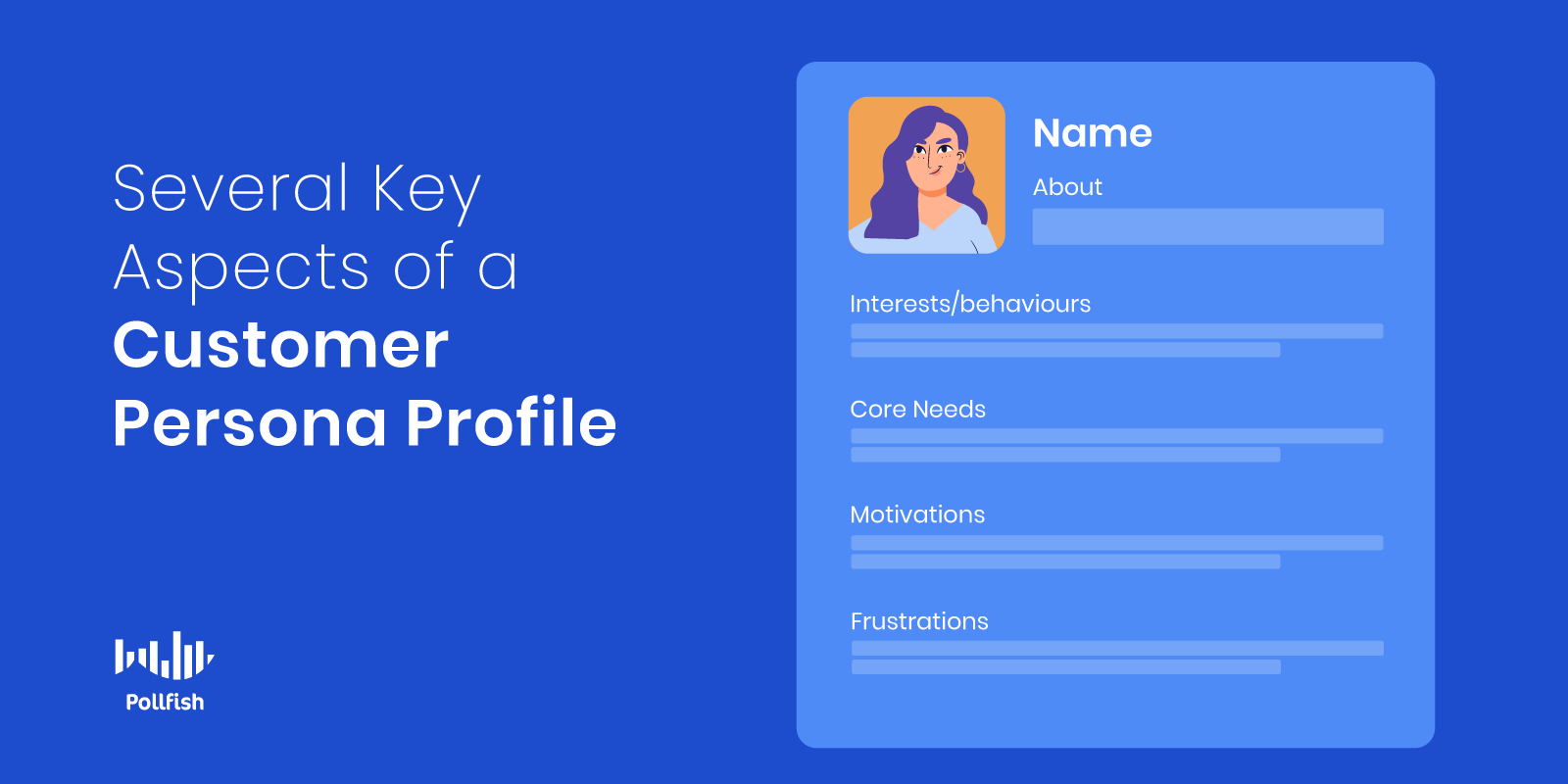
The following enumerates the key factors of customer personas so that businesses can understand them thoroughly and easily form their own:
- Demographic details
- This includes age, gender, income, marital status, location, race, ethnicity, number of children (if any), etc.
- Customer behavior
- This includes all the actions and behavioral patterns of how customers shop, consume and discard products.
- Pain Points & Objections
- Paint points involve the challenges that customers typically face, how they feel about them and how a business can help them overcome or bypass these challenges.
- Objections include frequent dislikes and concerns in regards to a business, its products, services and experiences.
- Workstyle
- This involves their industry, position, salary, area of responsibility, decision-making authority.
- Lifestyle
- This concerns what customers and leads do in their spare time, what they enjoy doing, their hobbies. whether they own a vehicle, etc.
- Personality
- This is a snapshot that includes determining whether customers are competitive, emotional, logical, outgoing, people-oriented, how quickly they make decisions, etc.
- Goals
- This explains what they hope to do or achieve. Are they more career-focused and want to impress their boss and colleagues? Are they interested in saving money or time?
- It also addresses what would make them purchase from a business in relation to their goals.
- Information Consumption
- This regards how customers prefer to receive and consume information, such as doing internet searches, scrolling on social media, talking with people, reading newspapers, watching various broadcasts, listening to podcasts, reading magazines, etc.
- Designated Marketing Message
- Composed of a few sentences, it outlines how a business helps their customer personas relieve themselves of their pain points and meet their needs.
- Identity
- This includes a name and a stock photo to humanize and visualize the persona, since it is meant to represent a real person.
The Importance of Identifying Customer Personas
Buyer personas are important for businesses on a number of different fronts. All of these bring different kinds of value across departments.
First off, these personas give businesses a comprehensive view of hypothetical customers, one that is far more concentrated and precise than a market segment. Their key factors such as their goals, motivations and lifestyles helps businesses form better targeted marketing campaigns and messaging.
In fact, 90% of companies that use customer personas were able to create a clearer understanding of their target market. In addition, 24% of companies gained more leads by identifying their personas.
These entities help guide numerous business strategies, such as brand voice, product development (such as in customer development, for example), social media campaigns, advertisements and more.
Given that marketing personas form the basis and style of a number of business activities, they align various departments, such as marketing, sales, product development and customer support, by giving them a concrete profile on ideal customers. This way, these departments can strategize to satisfy these personas accordingly.
Identifying personas can make a business more competitive and avoid product pitfalls. This is because persona-building involves establishing and addressing customer pain points and objections. These factors help businesses understand what’s bothering customers, what they dislike about current products in their niche and mainly, what would make them leave a competitor and switch to their brand.
Thus, product developers can refer to personas when forming product roadmaps, as they help them discover and prioritize changes to product offerings based on customer needs.
Marketers can identify and prioritize promotional activities to use in digital ads, remarketing and retargeting efforts with buyer personas. Content marketers also benefit from personas, as they help guide thor copy and build a content strategy relevant to customers.
These personas are useful for sales teams as well, given that they allow sales employees to understand the needs and pain points of their prospects, enabling them to be more prepared and better versed in dealing with prospects' concerns.
All in all, customer personas help a business understand its customers at deeper levels, in turn allowing them to better empathize and serve them, while improving their own processes with better alignment across departments.
How Market Research Helps Build Customer Personas
Firstly, market research helps build these profiles with the critical preliminary process of market segmentation. The importance of market research also extends to building specific personas themselves.
First off, there are various market research techniques that businesses can incorporate to learn more about their target market. Secondary resources are often used in the early stages of learning about a particular target market. While secondary research helps form the bedrock and key insights on customer needs and behaviors, it cannot address specific concerns that businesses have, let alone form personas that are unique to a business.
Therefore, a business must always conduct primary market research. There are many means of conducting firsthand market research; surveys provide the most simple yet potent method to collect such research.
This is because surveys allow businesses to study the exact people who fall under specific demographics, geographies and even behavioral traits, should the online survey platform allow it. In this way, market researchers can learn about their desired populations only, further segmenting them and using their data to identify and build personas.
Surveys provide an easy method of gaining a wide swath of insights and can be based on any campaign or sub-campaign. When it comes to forming buyer personas, they allow market researchers to gather information on all the factors that make up a bury persona.
Nobody likes taking long surveys, as such, researchers can design surveys on different factors of the personas in their process. They can also create follow-up questions on a particular topic to unlock deeper insights.
Surveys allow market researchers to quickly draw responses and even provide a completion time, depending on the online survey platform. They also grant researchers different data viewing and exporting options in order to analyze their data to their preferred method.
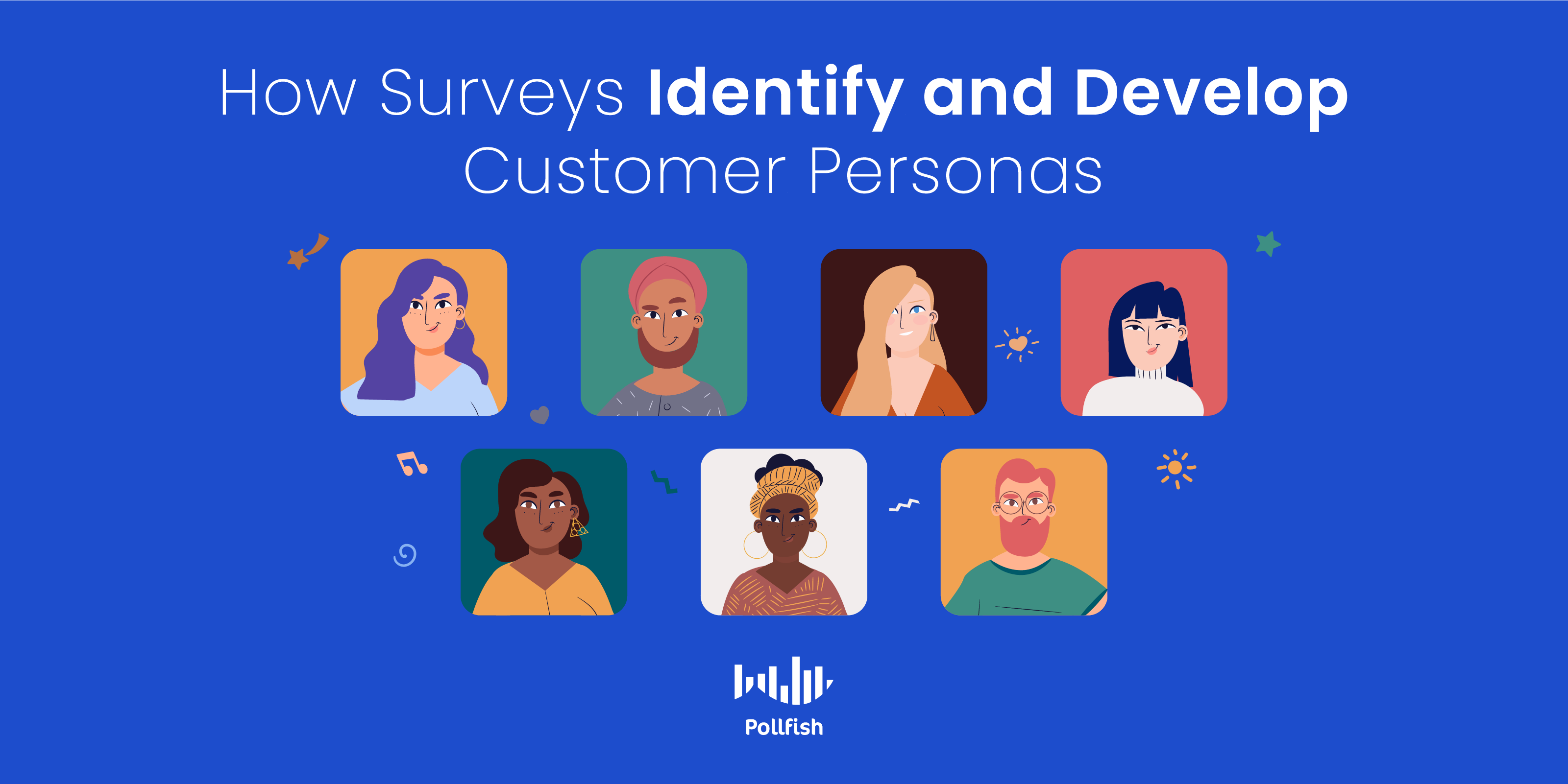
Surveys can uncover key trends and patterns crucial to the makeup of a customer persona. They also allow businesses to gain access to thousands of respondents.
The following presents just some of the insights that surveys can effectively provide:
- The backgrounds of customers, including their lifestyle, workstyle and demographics
- The challenges and hurdles they deal with
- Their interests and hobbies
- What they seek in a product or service
- What they dislike or try to avoid
- Their goals and needs and how a business can help attain them for customers
- How a business’s solution alleviates their challenges
How to Create Surveys that Identify and Build Customer Personas
Creating surveys for the purpose of developing customer personas can be difficult, even for those with some familiarity of market segmentation and building personas.
The correct online survey platform should relieve this process with functionalities that allow researchers to screen respondents, create questionnaires and deploy surveys.
The following lists the necessary steps to create surveys to identify and build customer personas:
- Determine the main purpose and needs of the survey campaign.
- Decide on the main needs of your campaign.
- Pinpoint the unknowns of your buyer personas. Do you need to understand them better, or do you need to create new ones entirely?
- Does your business seek to form a more personal connection with its customers? Or do you need to understand their problems more clearly, to ideate solutions?
- Assign your survey to specific target populations.
- First consider who you need to take part in your survey: existing customers, website visitors, your general target market or a specific segment from it?
- Finding who you need to involve in survey research can also help narrow down the purpose of the campaign in Step 1.
- Narrow down the premise and setup of your survey.
- Although similar to Step 1, this step involves taking the purpose of your survey and using it to settle on a persona subtopic, or several, such as customer goals, objections, pain points and buying behaviors.
- If you have some of this information on your personas, consider whether you need to explore new topics to build the persona further or gain more information on existing aspects.
- Form the questionnaire.
- Begin with general questions and make them more specific.
- Consider using advanced skip logic to route respondents to a relevant follow-up question to the previous question.
- Use a variety of question types to make the survey more engaging and avoid survey fatigue.
- Some questions will need more specific answers, so consider using both multiple-choice, multiple-selection and open-ended questions.
- Send out the survey to its intended respondents.
- Don’t forget to include a thank you section to the survey, along with an intro that briefly explains its purpose and the importance of the respondent’s participation.
- Assure that the platform you use allows for randomization and the random device engagement (RDE) method.
- Analyze your survey results.
- Organize them into a document that lays out patterns and common findings.
- Filter the findings into a customer persona profile or profiles, if you suspect the presence of more than one, or traits that apply to partly established personas.
- Put together your marketing personas based on your survey research.
- You can use the data you reaped from your survey campaign into existing personas or create new ones. Additionally, you can add another aspect to an existing persona if you haven’t already. For example, their buying behavior, if you haven’t formed this aspect in previous persona-building studies.
- Consider if you have enough information on each persona. If you need considerably more, run another survey and ask questions specific to the missing gaps on your persona(s).
Creating the Most Effective Marketing Campaigns
Mapping out a plan for effective marketing campaigns requires knowledge about your customer base. In order to form successful marketing and sales campaigns, businesses must be attuned to their customers to make informed decisions.
Customer personas allow businesses to do just that, as well as align all team members on all their customer-facing efforts, from the support team to the product team. With these personas, businesses can even designate an upcoming campaign or sub-campaign to particular personas. This way, they can jumpstart a campaign with targeting already set.
Survey research provides businesses with ample data and insights, depending on how they set up their questionnaire and how often they deploy surveys. Surveys are also strong tools to use for forming customer personas, allowing market researchers to gain a deep read of their customers on multiple factors.
Aside from asking relevant questions, using the correct online survey platform is vital for building buyer personas. Such a platform should offer advanced skip logic to direct respondents to relevant questions, allow for a multitude of questions and pre-selected answer ranges, deploy surveys to a vast network of users in their natural digital environments by using the random device engagement sampling method and be easy to use.
When researchers are equipped with a strong online survey platform, they can take their customer persona-building campaigns to new heights.
How Surveys Influence Customer Buying Behavior
How Surveys Influence Customer Buying Behavior
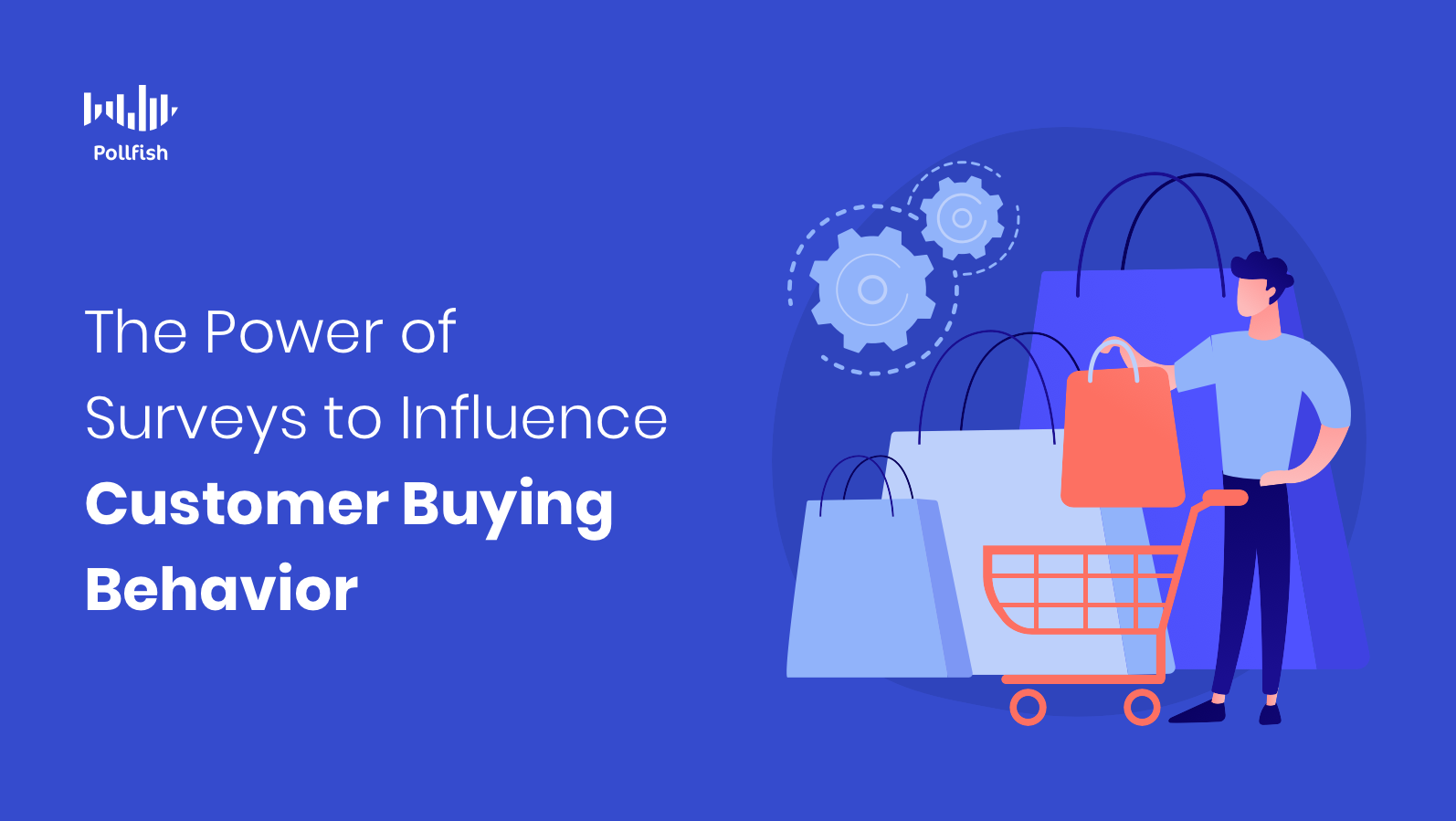
All businesses must examine their customer buying behavior in order to survive, not least if they seek to flourish. This is notably due to the direct effect this behavior has on patronage, such as sales, site visits, in-store visits, intent to purchase, customer loyalty and more.
Thus, all businesses ought to keep a close eye on their customers’ buying behaviors. There are a number of ways to do this. Market research techniques offer the most data-driven approach to understand these behaviors and a business’s target market at large.
Surveys, in particular, offer quick access into the minds of consumers, allowing businesses to study them at their whim and procure intelligence on their many facets, such as their sentiments, opinions and buying behavior.
But did you know, aside from studying customer buying behavior, surveys can also influence it? In this way, the surveys themselves act as marketing and advertising vehicles that allure customers to specific brands.
This article explores the concept of customer buying behavior, its importance, its four types and more, along with how surveys alone can influence it.
Understanding Customer Buying Behavior
As its name implies, this is a kind of customer behavior, one that is especially concerned with how customers buy, along with the actions and behaviors they take part in before purchasing.
Customer buying behavior refers to the ways in which a target market, the customers most likely to purchase from a business, acts when shopping for a product. Customer buying behavior takes into account the entire customer journey — from discovery, to nurturing, to browsing, to purchasing and possibly repurchasing.
This “behavior,” or rather, set of behaviors is shaped by personal and aided factors, along with external and environmental factors such as social climates, issues and occurrences. All of these play a role in driving customer perceptions of a brand, thereby driving their buying decisions, whether they are rational or irrational.
Buying behaviors take place both on and offline before customers make a purchase.
Given that customer buying behavior encompasses a wide breadth of interactions, such as searching for a product on a search engine and discovering a brand that sells it (SEO and SEM), engaging with a brand’s social media or reading marketing collateral, marketers have plenty of environments to observe their customer buying behaviors.
As such, marketers and market researchers study customer buying behavior to better produce marketing initiatives that influence customers to make purchases.
The Importance of Customer Buying Behavior for Businesses
This phenomenon is critical for businesses to study and especially to influence. When a brand has enough sway over its target market, it will generate more revenue, customer loyalty and a longer customer lifetime value (CLV).
When businesses fully grasp the customer buying behavior of their target market, they can intelligently conceive and carry out different marketing campaigns. In this way, understanding customer buying behavior not only guides marketing efforts, but helps avoid missteps, errors and wasting time and resources.
It is critical to examine buying behaviors, as they are not stagnant. Since the beginning of the pandemic, 48.7% of customers changed their buying behaviors, switching their purchasing preferences to the digital space. That is because they replaced products that they regularly bought at physical stores with competitors' online shops.
Additionally, in the wake of COVID-19 click and collect sales grew in the US by 60.4%, attesting to the popularity of buying items on the internet, however merging internet purchases with physical pick-ups, that is, at a store or retail hub location. This comes as a rather
Customers also change their buying behaviors in terms of brand switching. This has been documented during the pandemic, as 36% of consumers tried a new product brand in the midst of COVID, while 25% of customers switched to a private-label brand.
73% of consumers who have switched brands will continue using their products regularly, which means that they will either use the new brands alongside the brands they’ve used before, or completely replace the old brands with the new one(s).
Thus, all businesses should expect their target market to either switch or try their competitors’ products and services at some point. In this way, studying and influencing customer buying behavior largely affects customer retention and loyalty.
When businesses have a solid understanding of their target market’s buying behaviors, they can produce messaging that is better targeted, thus resonating with certain market segments. This helps improve brand equity and will generally leave customers with a better impression of a business.
Additionally, it allows companies to understand when customers typically make purchases so that companies can target their messaging accordingly and reach consumers when they are most likely to shop. For example, some businesses may observe that customers buy during the weekends or on the evenings of weekday nights. Thus, it would be apt to incorporate a new sales banner or social post during those times.
All in all, paying heed to customer shopping behaviors helps businesses on several fronts.
The Key Influences on Customer Buying Behavior
As aforesaid, there are various factors at play when it comes to influencing customer buying behavior. First off, there are the external factors, such as current events, social and political issues and other emotionally evoking happenings.
In 2018, a Harvard professor reported that emotion is one of the biggest drivers of buying behaviors and decisions in general. Thus, brands ought to study their customers’ emotions, particularly their responses to current issues.
Some customer segments may be inclined to buy from socially responsible companies: companies with business models that focus on social change via philanthropic, charitable or activism-based activities. Others may have a buying behavior influenced by such companies.
But there will always be customers who gravitate towards a brand that supports a cause or idea that they too care about. Thus, it is crucial to understand the key influences of customer buying behavior.
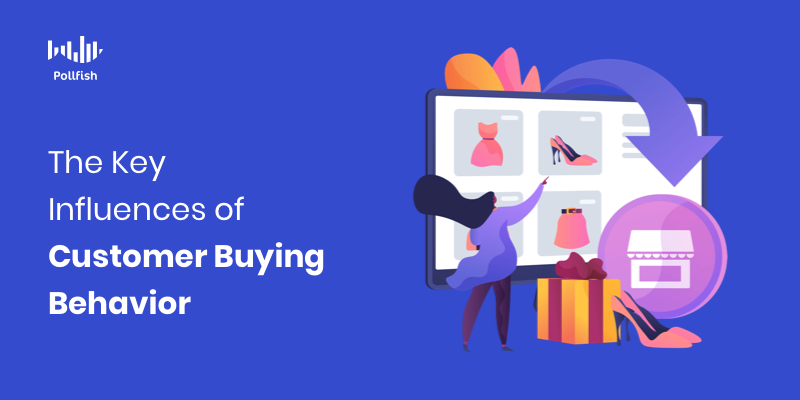
Aside from the way companies present themselves in relation to external issues, there are three other key influences on customer buying. The three other key components are:
- Rational considerations of the product and service. These include:
- Price, quality, and convenience
- Mental or cognitive factors such as product utility and value
- Irrational considerations such as feelings and desires. These include:
- Emotional, aka affective factors such as irrational considerations, which include personal beliefs
- Behavioral aspects such as
- Buying patterns
- Preferences based on routines and habits
The 4 Main Types of Customer Buying Behaviors
When customers make purchases, their buying behaviors almost always fall into at least one of four categories. These categories classify a wide range of situations that can occur in similar ways based on the behavioral aspects of the scenarios.
The following explains the four main types of customer buying behaviors:
- Complex buying behavior
- The most typical buying behavior
- This usually occurs when buyers make big purchases, such as a new vehicle or real estate.
- This type of behavior includes a high level of research and prudence before choosing a product.
- As such, this kind of behavior involves long considerations before customers make any purchase.
- This behavior stems from an instance in which a purchase will have a significant impact on a customer’s life, especially when the purchase involves risks.
- Habitual buying behavior
- This refers to customers who buy the same product repeatedly.
- Such customers manifest a high level of product loyalty.
- This involves brand loyalty, such as buying from the same bread company during each shopping trip or online visit.
- Consumers who engage in habitual buying rarely research alternative products of brands.
- They don’t look for similar brands or products as they are used to buying a particular kind (or kinds). Thus, they exhibit the most customer loyalty.
- Variety seeking buying behavior
- This behavior stands in opposition to habitual buying behavior.
- Consumers with this buying behavior look for variety because they have yet to find their favorite product.
- This kind of behavior takes shape when customers seek novelty in their would-be, go-to products.
- For example, when customers try different hair-dying brands before settling on one.
- Customers with this buying behavior carry little to no brand loyalty.
- Dissonance reducing buying behavior
- This occurs when customers are afraid to make the wrong buying decisions.
- This behavior stems from a fear of buyer’s remorse.
- It is especially prevalent in situations where customers cannot return items should they not be satisfied, or when returning products is too difficult, such as in the case of a faraway store or expensive return shipping.
- This behavior comes about when customers’ have a bad past experience with a particular product.
- This often occurs when customers spend more time comparing different aspects of a product rather than comparing different product brands.
How Surveys Influence Customer Buying Behavior
Although there are many ways businesses can study customer buying behavior, they can also take part in activities that influence their customers’ buying habits. There is also a means that offers businesses with a twofold prowess: being able to study customer buying actions and influence customer behavior as well.
The solution that offers this dual prowess is a market research survey. Surveys give businesses and market researchers access into the minds of their target market. There is a vast amount of surveys and broader survey research methods.
Businesses can run survey campaigns for all 6 of the main types of research. As such, businesses can probe their customers’ buying behaviors by deploying surveys to their target market online. They can also send surveys to specific segments of their target market.
Surveys have the ability to reveal major aspects of consumer opinions and sentiments, thereby allowing businesses to examine their buying behaviors. This is because surveys allow businesses to ask their respondents virtually anything, allowing them to better deliver their marketing messaging, images, advertising and other campaigns.
Thus, by studying customer behavior through surveys, businesses can make more informed decisions, the kind that can allow them to produce more effective marketing campaigns.
However, since surveys offer a dual power, their ability also extends to influencing customer buying.
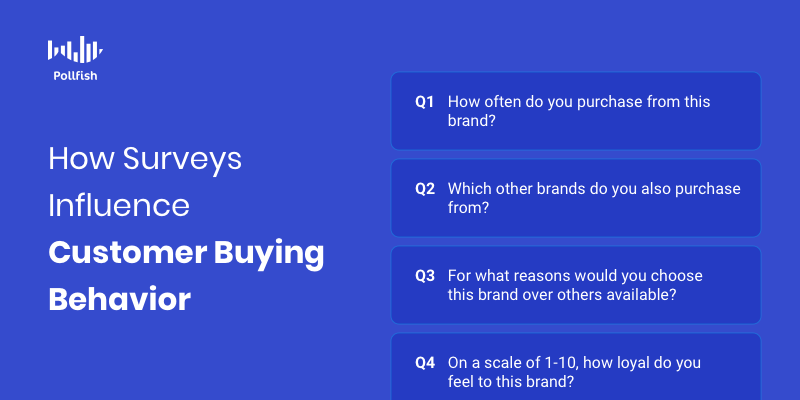
Several years ago, Harvard ran a study to discover how surveys can affect customer behavior. The results of the survey study bear good news for businesses; as it turned out, customers that were surveyed were more than as likely to open new accounts with businesses.
In addition, this study discovered that the customers who were surveyed were less than half as likely to renege on their patronage and were even more profitable than the customers who weren’t surveyed.
This study reveals that surveys have the power to present a brand in a positive light, or at the very least, bring brand awareness to a brand that target customers may otherwise not have heard of.
Thus, businesses that wish to influence their customers’ purchasing behaviors ought to conduct surveys. They must bear in mind that in order to influence their customers via surveying them, the surveys must mention the business by name. Companies must paint their brands in as positive a light as they possibly can. This includes making light of the fact that they support causes that their customers care about.
The more surveys that businesses run to study buying behaviors, the better they can present themselves in upcoming surveys to influence their customers.
Creating the Strongest Behavioral-Influencing Campaigns
Surveys are an excellent approach to reaping intelligence on customer buying behavior, as well as influencing this behavior. However, in order to maximize both efforts, businesses must use the proper online survey platform.
All online survey tools are not built with the same dashboards, capabilities and interfaces. Thus, market researchers should research the available online survey software before deciding on one platform to run all of their market research campaigns.
Given that these platforms offer a primary means of research, they must be chosen carefully. The most convenient online survey platforms will offer various capabilities, ease of use, deployment across a wide network of digital properties, including websites and apps, along with artificial intelligence and machine learning to stave off faulty answers and poor data quality.
Moreover, such a platform should offer global support, so that businesses can rely on experts to guide them with their surveys at any point of the day. A survey platform of this caliber will make it easy to both examine and influence buying behaviors.
Market Research Vs. User Research: Which Does Your Business Need?
Market Research Vs. User Research: Which Does Your Business Need?

Market research vs. user research: which is more important? This is the question many businesses must contend with. One thing is for certain; a business needs to conduct research in order to identify viable opportunities, latent threats and customer sentiments and needs.
In today’s age of evolving digital technologies, customer needs have also become more demanding — 63% of consumers expect businesses to know their needs and expectations, while 61% of customers have switched to a competitor after a bad customer service experience.
Businesses must therefore be discerning on the research they decide to use, whether it comes from in-house or external providers. Usually, combining both kinds is necessary in order to conduct both primary and secondary research.
Market research and user research apply both; additionally, both of them can be used within the 6 main types of research.
This article provides insights when facing the market research vs. user research debate so that you can determine the aptest kind of research for your business.
Defining Market Research
Market research is a term that encompasses several processes and methods for extracting information about a market. Specifically, it denotes the practice of collecting, analyzing, interpreting and consolidating data on your customers and industry at large.
This includes gathering data and information on your competitors, target market and your own products, services and experiences. As such, it refers to a holistic approach to gathering research for your business, as it relates to your business and its overall niches and industry.
Conducting market research is essential for understanding your target market — the segment of customers most likely to buy from you. Additionally, it allows you to make continuous improvements to keep up with changes in customer opinions, attitudes, behaviors and demands.
Aside from enlightening your business on its CX, market research allows you to understand the inner workings of your entire field, from your direct competitors to those not within your niche, to innovations and much more.
The Importance of Conducting Market Research
Performing market research is crucial for businesses big and small, for the reasons stated above and several others. First off, market research entails gathering secondary data from virtually all sources that pertain to your business and its encompassing industry.
From checking your competitors’ digital properties to keeping tabs on their ads and social media, along with turning to trade publications, news, statistics and market research websites, it allows you to stay informed on all the ins and outs of your industry.
Then, there’s the customer side. Market research ensures a satisfying and friction-free customer experience by studying the concerns of your customers. This goes beyond studying secondary source trends and statistics.
Instead, primary research is a large component of the process. By conducting a consumer survey, interviews, focus groups, field research or running experimental research, you will gain a deep understanding of your customers. There are other methods of performing primary research, all of which fall under market research.

By studying your customers, you gain the imperative knowledge for catering to them, along with steering clear of their aversions. As such, you can avoid issues that tarnish your brand’s reputation along with those that trigger customers to patronize your competitors.
You can also run market research campaigns on your own products and services, to see how your target market truly feels about you. This practice can also help you discover what’s missing in your industry, allowing you to innovate more quickly.
Continuously running market research campaigns will thus guarantee you stay well-informed on all the concerns, needs and opportunities of your business and the overall market.
The Pros and Cons of Market Research
While invaluable for businesses who wish to not merely stay afloat but to become and remain competitive, market research also carries a few drawbacks. Businesses and researchers ought to be aware of both the benefits and pitfalls of market research.
The Pros
- Allows you to stay abreast of all changes, behaviors and innovations within your industry.
- Enables you to conduct market segmentation to discover the segments making up your target market.
- Grants you insight into all of your target markets’ needs, attitudes, aversions and sentiments.
- Helps you brainstorm and strategize more effectively, as you are equipped with data.
- Limits risks and liabilities.
- Propels higher sales.
- Measures viability of new products and services.
- Helps you find the gaps and limits in your industry, ideal for creating new products and offerings.
- Finds new markets and niches you can explore and eventually serve.
- Supports all decision-making processes.
The Cons
- The total sum of all the research that makes up market research can be expensive.
- It forms a long and winding process, which can make certain campaigns feel boundless.
- It requires keeping track of ongoing changes, as such, certain sources may not be as relevant and accurate of the industry.
- There are biases present in many sources of information:
- Primary research: survey bias, lack of field research to form conclusions, dishonest interviews, etc.
- Secondary research: biases in secondary publications, outdated content rebranded as new (via date changes but no updates)
Defining User Research
User research comprises far more than usability testing. Also called design research, user research aims to study the users at the center of the design process of your products and experiences. As such, it involves examining the various needs, concerns and pain points of your target users.
This kind of research is primarily useful for product designers and experienced producers, who use the insights from user research to make educated decisions for decisions. With this form of research, designers avoid or reduce product glitches, gaps and producing things with scant market demand.
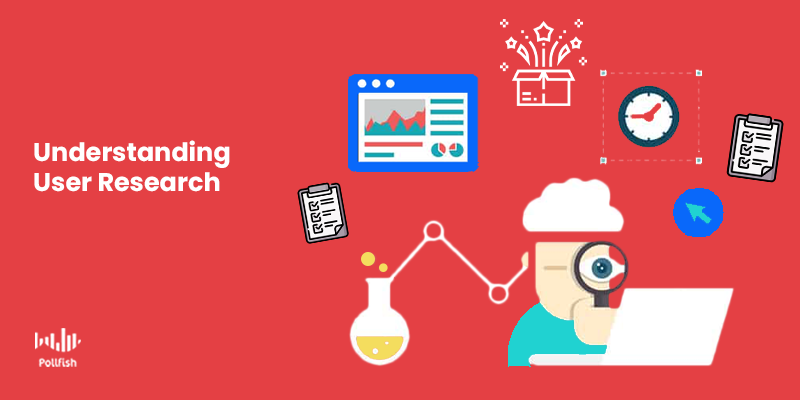
Like market research, it relies on a wide range of methods and processes in order to gain the information the designers and product managers seek. The various components that form user research can thus be used to discover design opportunities and crucial information to guide the design process.
User research involves conducting ethnographic studies via interviews or performing user testing, quantitative research on the ROI of your products and UX designs and surveying your target market. The latter involves a wide range of topics, such as existing product satisfaction surveys, surveys on your product ideas, surveys on competitor products and many more.
Other user research methods and tactics include:
- Accessibility evaluations to ensure an inclusive design of your product.
- Studying customer journey maps, essential to understanding your customer journeys, is a major aspect of digital CX (customer experience) or UX.
- Studying website analytics to understand traffic, bounce rates and other metrics to learn which content engages and which requires improvement.
- Evaluate information architecture via card sorting so that you assure your design is structured logically.
- Conducting contextual inquiries via field research (in-store observations, observing product testers) and digital observations (chats, a customer experience survey)
The Importance of Conducting User Research
User research is of the utmost importance when it comes to design strategy, as it functions as a foundation for it, along with a continuous source of insights to strengthen it. It equips project managers, designers, markets and business owners themselves with key data to buttress your design ideas and decisions.
This kind of research allows you to pinpoint the best candidates for using your product, as well as the members of your market segments who would be most likely to engage with a digital asset. In turn, this aids your marketing strategy, as you’ll understand which segments to target in your marketing efforts.
User research can foster this activity, as creating a successful marketing strategy relies on avoiding the mistake of marketing to everyone. As such, you cannot target all the segments of your target market in the same way. You’ll need to create different messaging for each segment, some of which require marketing entirely different products and experiences.
User research thus forms the bedrock of a productive marketing strategy.
Moreover, user research forms the basis of a product-design cycle. While you may be confident in a product idea, design, or upgrade, it is useless if no one else has a need for it or finds it difficult to use. Thus, user research assures that there is both demand and, as its name implies, usability, within your product.
It avoids the further design, planning, development and expenditure of resources on an unwanted or faulty product or experience idea.
It also grants you insights into who the users themselves are, the context in which they’ll use your product or experience and the problem your product/experience solves. Additionally, it helps you understand all of their needs from your business, especially in relation to products and experiences.
Essentially, product success hinges on user research.
The Pros and Cons of User Research
While necessary to conduct, user research presents several deficiencies as well. Researchers and business owners should comb through both the advantages and pitfalls of user research before they set out on conducting it.
The Pros
- Without UX research, your design is left with nothing but assumptions and intuitions.
- Forms the initial steps of producing an entirely new product/experience or innovating on an existing one.
- Contextualizes the use of your products, such as the environments they are used in and the problems they help solve.
- Gives you deeper insights into your site users and customers.
- Ensures you create products that your target market desires.
- Helps you avoid usability issues and glitches.
- Saves you both time and money on flawed products or those that your target market doesn’t need.
- Allows you to understand what your users don’t use your products/experiences for.
- Ensures you evaluate your design with data reflecting the needs and behaviors of your users.
- Lets you understand the impact of your design on your target market.
The Cons
- Users don’t always remember everything they do and use a product for.
- User research data is complex and thus requires plenty of time to conduct, consolidate and analyze.
- The risk of researching the wrong audience, as survey respondents and other study participants may be dishonest about using a particular product or experience.
- Confidentiality is not assured, as users may share screenshots of your products for competitors to see. This occurs in user testing and experimental research.
Market Research Vs User Research Faceoff
Aside from delving into the key specifics and of these two forms of research, the needs they help fill along with their flaws, it is useful to understand the key facts that separate them. The following graph shows the key differentiators between these forms of research.
| Market Research | User Research | |
| Focus | Customers, products and the market at large | Product needs, usage |
| Key components | demographic, behavioral, economic, and statistical information | Information on product needs, fits, uses, user movements, mechanisms |
| Sample size | Larger | Smaller |
| Representativity | High | Low |
| Theme | What people buy | How people use a product |
| Insights | Touch upon broader topics | Deeper insights on fewer topics |
| Quantitative/ Qualitative | Both | qualitative |
| Goal | Measure industry needs and trends, customers and competitors to release viable offerings | Measure and improve the user experience |
Which Method Does Your Business Need?
Market research vs. user research may appear to be something of a showdown, a battle in which only one form of research must be chosen. But when it comes to conducting either form of research, there is no battle or face-off.
Not to be anticlimactic but there is no winner in this “showdown” — which is not to say you’ll need all the types of research available, as aforementioned in the introduction. For example, some businesses may require correlational research, while some may only require causal research.
However, when it comes to market research vs. user research, there is no either-or. All businesses, even B2B businesses must conduct both forms of research.
This is due to various reasons.
Concerning the latter, there is a lot of overlap in these forms of research. For example, both heavily rely on using surveys to reap key insights from a target market. Both also involve studying the product and user experience. Both involve carrying out primary and secondary research.
As for the latter, although a B2B business may not offer any products, it will always rely on digital customer experience. It is virtually impossible to exist as a B2B business — or virtually any kind — without a website. Many such businesses also invest in social media and content marketing. As such, they’ll need to understand user experiences.
In summary, businesses can achieve success by conducting both market research and user research; the two exist hand in hand, with one buttressing the other. A strong online survey platform can plan, support and fully execute both kinds of research. As such, you’ll need to choose an online survey provider wisely.
The Complete Guide to Market Research Techniques
The Complete Guide to Market Research Techniques
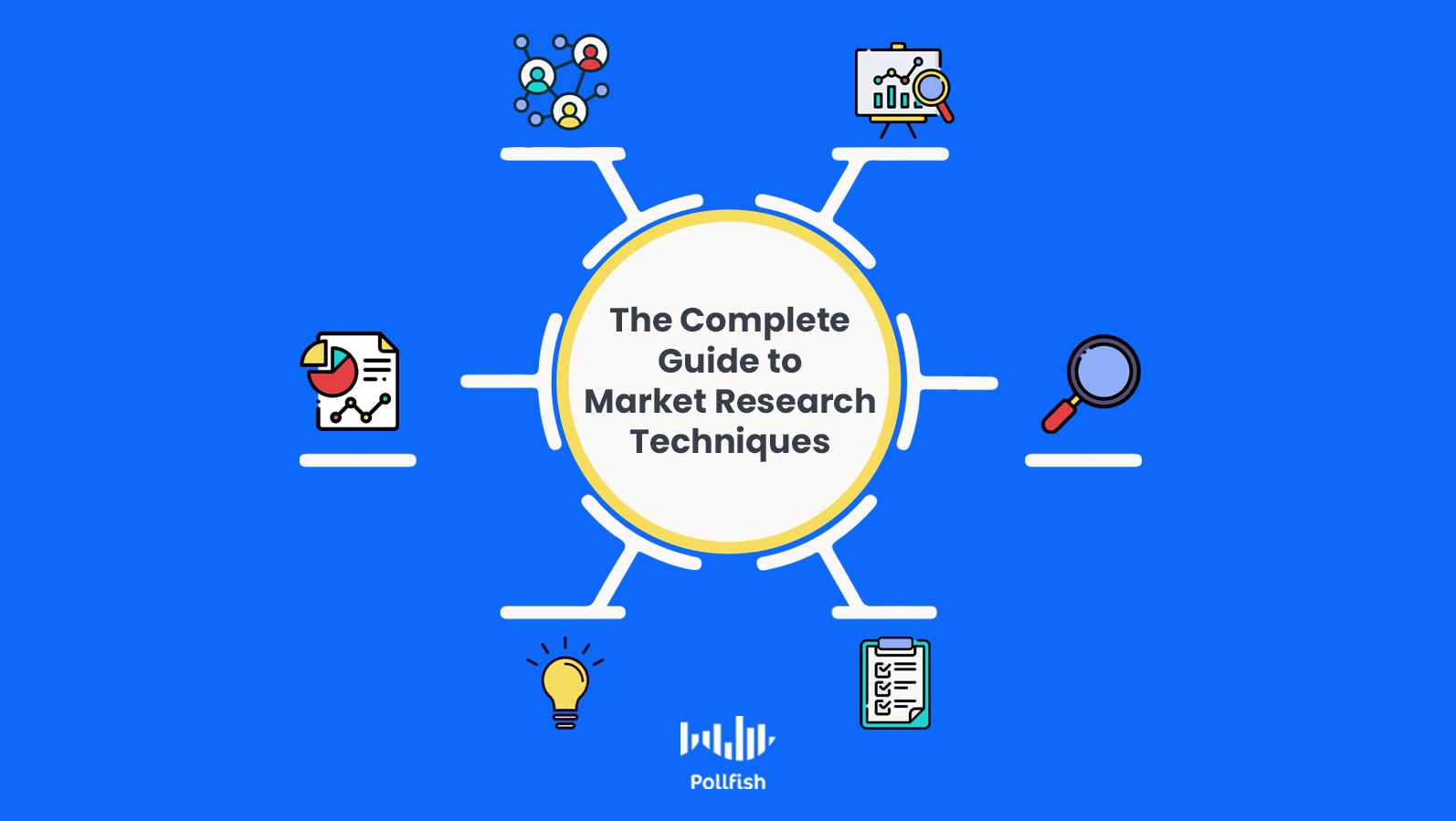
If you intend to conduct market research, you'll need to be well versed in market research techniques. These methods will help you carry out a sufficient market research campaign, allowing you to better serve your customers and steer your business toward.
But when you are facing a concept as broad as market research, it is rather challenging to know where to begin and how to conduct the various forms of research.
This complete guide to market research techniques will help lessen this challenge so that you can stride confidently into all your research needs.
Defining Market Research
Like several aspects of business, market research is not bound by one concept; rather it is an umbrella term that encompasses a wide array of practices.
Market research is the process of gathering information about your target market (the people most willing and likely to buy from a business), segmenting your buyer personas (market segmentation) and amassing knowledge on your competitors.
This category of research allows businesses to gain insights into the quantifiable aspects of their industry, along with the opinions and attitudes of past, current, potential and churned customers.
The ultimate end goal of market research is to learn how successful your product or service is and/or will be within your industry, niche and most importantly, within your target market.
Primary Vs Secondary Research Research
The chief divider of market research involves the method of researcher participation, aka, the way the research is conducted.
Primary research denotes an active form of research, in that researchers conduct the research themselves. This signifies that the information they are seeking has not yet been collected, or, that the research they need has been gathered, but they seek to gain their own, firsthand data.
As such, primary research involves using primary data, that is, the data that a researcher would extract themselves.
On the contrary, secondary research entails research that has already been conducted and (usually) has been made available. With this research category, the researchers aren’t required to amass their own intelligence; rather it involves aggregating knowledge that has already been collected and passed on by others.
As such, this kind of research largely involves summarizing, synthesizing and scrutinizing data and other forms of intelligence. Secondary research often involves studying the primary research that others have already conducted and packaged in their chosen form.
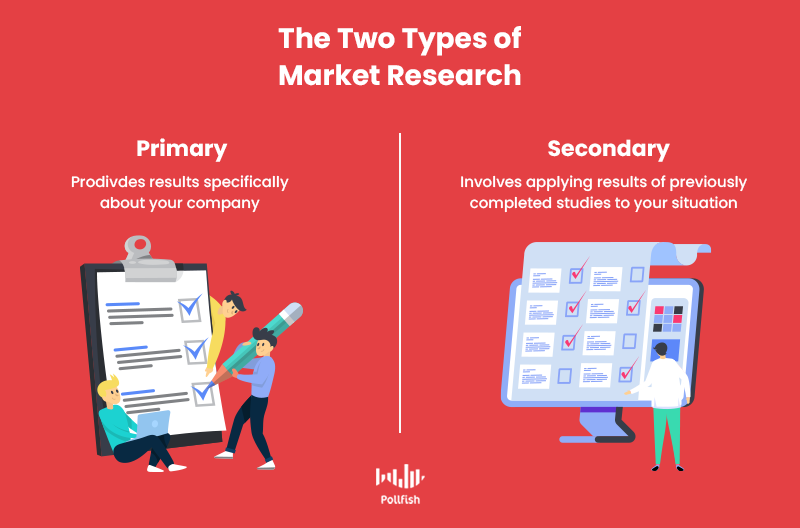
It is important to incorporate both styles of research for a comprehensive market research campaign. This is because there are going to be subjects that you cannot study simply through one form of research. For example, your competitors aren’t going to publish the primary studies that depict them in a negative light, no matter how accurate they are.
Another example is your own set of customers; secondary research alone is not going to provide an adequate amount of data on them. There may not even be any data on your particular customer segment.
Primary Market Research Techniques
Here are a few techniques for completing primary market research. Researchers need not attempt all of these techniques, as some will be more useful and easier to execute than others. It all depends on your preferences and goals.
- Interviews: One of the more intimate methods, interviews can be managed over the phone or in person.
- Focus Groups: A more interactive form of interviews, this technique gathers data from a group of about 6-10 participants. Focus groups study subject matter experts. Using a moderator, these groups aim to incite discussion among the participants. This is a good method to perform to learn about a specific segment of your target market. Focus groups rely on open-ended, broad and qualitative research questions.
- Field Research: This is an observational method on subjects in their natural environment. To use this method, researchers do not interfere with the outcome or behavior of a situation. This technique grants direct observation of people and their interactions. Ex: An electronics brand seeks to observe how customers interact with a new line of products. They may do field research on in-store customers to study this.
- Surveys: Online surveys are the best distribution method and allow you to study any topic. A strong online survey tool will enable you to set granular demographics requirements, ask a wide style of questions (multiple-selection, single selection, ratings, etc), add advanced skip logic, add media files and use multiple audiences per survey. Surveys can take many forms; business and consumer surveys alone form macro surveys that include their own survey types.
- Test Marketing: This technique involves testing the usage and opinions of a new product by selling it to a small segment of one’s target market. For example, software brands test-market by using the “beta” versions of new features/products on a small group of likely customers. This method helps predict how a new product will fare in a larger market.
Secondary Market Research Techniques
Secondary market research techniques require using sources specific to your industry and niche. While some sources may be general, you’ll need to gather intelligence most pertinent to your target market — or at least your industry. Here are a few citations to use for secondary research.
- Government Resources: The government collates massive data on citizens; this data is free and can be found on a number of government websites.
- The Census Bureau: Provides a portrait of the American economy, market sizes, populations, demographics and more. It includes the American FactFinder tool, which finds demographic, economic, social, household, and other data on geographic regions.
- The U.S. Small Business Administration: Captures statistics on economic matters such as employment, salary, income, sales and more. The SizeUp tool allows businesses to compare themselves against competitors.
- The U.S Department of Commerce: With offices scattered across the US, the U.S. Department of Commerce generates data on industries and their products and services.
- The Bureau of Economic Analysis, which is a part of this department, creates economic reports on income, expenditures, and even savings data on a quarterly basis. This site shows the trends in product/service demand based on spending.
- Enterprise Sources: These resources are not free, but offer invaluable insight into particular trades and subsectors.
- Trade Associations: Perfect for studying your industry, they’re made up of groups of businesses that cater to specific subsectors. Use the following to find your industry association.
- Research Associations: Composed of research analysts, these associations to be independent, although some are affiliated with trade associations. These organizations provide businesses with granular reports on specific subsectors of an industry. They include:
- Forrester: Research in the consumer business and tech sectors.
- Statista: Statistics, reports, infographics & more on 170 industries and 150+ countries.
- Gartner: Research for senior leaders with business insights, advice and tools.
- IBISWorld: Industry reports by sector and country.
- Mintel: Market intelligence across industries and countries.
- Dun & Bradstreet: Data, analytics, and commercial insights for businesses with 120 million business records on over 1,000 industries.
- Industry Blogs and Content-Oriented Websites: Each industry has online publications dedicated to reporting on them. These are useful for the latest updates, trends and breaking news, the kind that a major report or downloadable asset may not provide. Here are a few examples across different industries.
- Ars Technica: A website covering news and commentary on the technology, science and politics space.
- The Business of Fashion: News and intelligence on the fashion industry.
- Grocery Drive: News that focuses on the grocery and ecommerce spaces.
- Premium Beauty News: Markets, trends, laws, new products and other news within the cosmetics industry worldwide.
- Realtor Magazine: News surrounding the real estate industry.
- Educational Institutions: Colleges and universities have research departments that study a wide range of business data. These insights are not free but involve heavy-duty market research from faculty and students. They include:
- Graduate student projects
- Faculty-based projects
- SEO and SEM Reporting: SEO is critical to growing your business online, as your target market won’t purchase from your business if they don’t find it. SEO/SEM sites help you gather keyword research to learn the most relevant to your niche.
- SEMrush: For SEO, PPC, content, social media and competitive research.
- Moz: For rankings, keywords and link testing.
- ahrefs: For rankings, site audits and keywords.
- Google Keyword Planner: For finding keywords, tied with Google Ads.
- Screaming Frog: A site crawler for technical SEO site audits.
Quantitative Research vs Qualitative Research
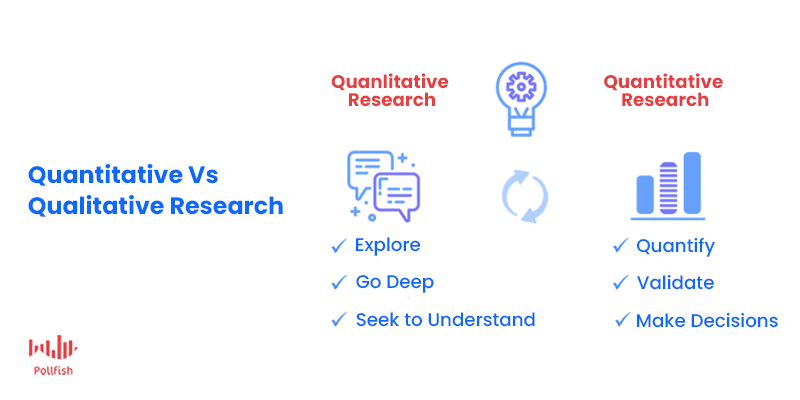 Another crucial market research division is that of quantitative and qualitative research. Unlike primary and secondary research, which can exist without one another, quantitative and qualitative research are used in complementation.
Another crucial market research division is that of quantitative and qualitative research. Unlike primary and secondary research, which can exist without one another, quantitative and qualitative research are used in complementation.
This means you would often use both in your research campaigns.
Quantitative research is marked by measurable data that quantifies the opinions, attitudes and experiences that respondents report. It collects numerical data for producing statistics, finding prevalence and identifying patterns.
The goal of quantitative research is to test a theory or hypothesis. Another common objective is to measure opinions in regards to a particular research topic. Quantitative research is also used to find causal relationships between variables, predict outcomes and create generalizations on broad populations.
Computing an instance or phenomenon takes precedence in this form of research, rather than gathering the reasons and motivations behind it. This kind of research works out the “who” and “what,” of a research subject.
Qualitative research stands in contrast with quantitative research, as a descriptive form of research. This form of research inquires into the depths of an attitude, opinion or phenomenon. Instead of delving into the statistical aspects around a research subject, which is known as the “what,” it works to find the reasoning behind it.
As such, this research doesn’t seek to describe a situation, opinion or occurrence; rather it focuses on establishing the “why” behind it.
Qualitative research was designed to take place in natural environments, i.e., places in which research participants can provide thorough answers. This environment can take place on or offline.
This form of research relies on using psychological, ethnographic and sociological approaches to study a target market. The design of a qualitative study evolves (along with the participants it studies).
In this form of research, there is no such thing as a single reality; rather it is changeable and subjective. It is highly interpretive, as it doesn't involve simply adding or crunching numbers.
Quantitative Market Research Techniques
Quantitative research involves using methods that collate measurable data that can be encapsulated in graphs, charts, tables and other visualizations. Here are a few techniques for gathering this kind of data:
- Experiments: Researchers can conduct experiments on products, such as producing beta versions, as tech companies do. They can also do A/B testing on digital experiences such as digital ads, emails and even on-site experiences. Additionally, researchers can run experiments in-store to test customer satisfaction with employee service and product layouts.

- Observations: Part of field research (as mentioned under primary research), researchers can observe customer behavior and occurrences in natural environments such as in-store behaviors. Observations can also exist online, for example, by using session replay tools found in analytics software.
- Statistics and other Published Resources: Researchers can garner quantitative data by studying secondary research. The technique involves looking at statistics websites, along with other data sources such as infographics and reports. This is a good starting point when dealing with quantitative data; it can also be used to compare findings between past and present data.
- Surveys: Perfect for discovering the “what” with multiple choice and multiple selection questions. Matrix questions help find the intensity of a phenomenon. There are swaths of different survey types you can implement, including macro ones like business surveys and consumer surveys, along with specific surveys such as the Net Promoter Score (NPS) survey or the Employee Satisfaction Survey.
Qualitative Market Research Techniques
Quantitative research techniques necessitate being able to understand opinions in more depth to uncover motivations, reasonings and consumers’ general psyche. These methods do not require quantifying any findings. Instead, they require using exploratory and open-ended questions; the kind that fully reveal the bedrock of consumers’ attitudes.
Here are a few techniques:
- Focus groups: These spur natural discussions by incorporating a small group of people with a moderator who prompts various conversations. Focus groups consist of people who share demographic attributes to study a target market or a segment of it. Unlike interviews, which are one-on-one, focus groups allow multiple people to speak, mimicking natural discourse and therefore having the participants influence each other.
- Unstructured interviews: Unstructured interviews are in-depth interviews in which there are no premeditated questions. Instead, the interviewer asks open-ended questions that relate to the research topic. This way, the conversation runs like a natural exchange. The interviewer would keep questions relevant to both the research topic and the participant’s experiences.
- Textual and visual analyses: A form of secondary research, researchers can draw analyses from qualitative research documents already available. This including looking at trade publications or research publications that focus on various consumers and other demographics.
- Case Studies: This technique uses thorough investigations on a participant, a group, an event or a community. It merges various sources such as interviews, observations and surveys. Researchers analyze the data from these sources and put together the case study document. This is used in clinical medicine, but can be applied to numerous other industries, including the general business vertical. This method uses both information from the past (retrospective) along with present and everyday manners.
- Surveys: Surveys can be every bit as qualitative as they are quantitative. In a qualitative survey, you would use open-ended questions. These often dovetail to quantitative questions by going more in-depth on them. Thus, you would need to use skip logic, so that if a respondent replies in one way, they would get rerouted to the appropriate follow-up question. Like with quantitative surveys, qualitative surveys can be applied to macro concepts like in cross-sectional surveys or for more specific ones, such as with community feedback surveys.
Other Forms of Market Research Techniques
Aside from the above two major types of market research classifications, there are several other major kinds of research techniques. Here are a few vital examples:
Retrospective Research
This research studies past events to see if or how they contributed to a current topic of interest. Also called historical research, this study inspects historical data. It falls under cohort studies, which follow a group of participants bound by a similar trait. This research uses observational studies that determine how often a phenomenon occurs within a targeted population. Techniques include:
- Survey panels
- Longitudinal surveys
- Interviews
Cross-Sectional Research
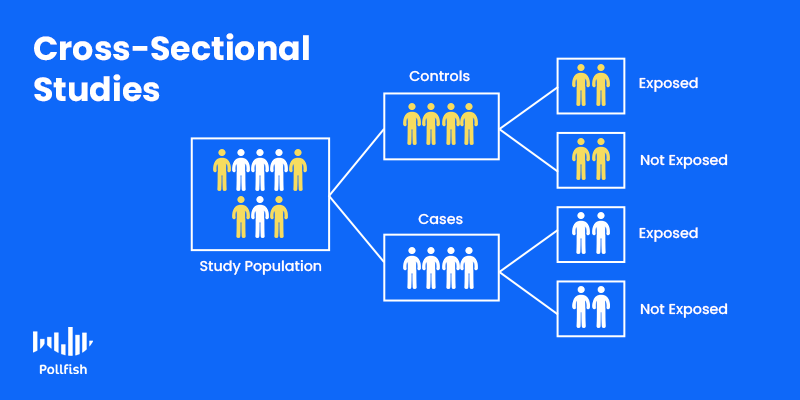
A cross-sectional study collects research on a particular population at one fixed point in time, essentially serving as a snapshot (aka cross-section) of a studied population. This type of survey does not require using a survey panel as this method follows a panel over several points in time. It is contrary to longitudinal studies, since they study participants at ongoing frequencies. Instead, it seeks to gain an overall portrait of a phenomenon during its time of study. Techniques include:
- Field research (especially recent studies)
- Interviews
- Surveys (Ex: community feedback surveys)
Prospective Research
Prospective research aims to predict the likelihood of a future event or issue. It is focused on outcomes and can also determine relationships between variables. A prospective study usually involves investigating a cohort of subjects over a long period. This research tends to be experimental in nature, as it seeks to uncover relationships between variables. Techniques include:
- Experiments
- Trials
- Longitudinal Surveys
- Focus groups
- Survey panels
Wading the Waters of Market Research
While this guide covers the most pertinent and useful forms of market research technique, there are still more to explore. That is because certain techniques, such as survey research methods have many forms and subsets of methods that brands can apply to their campaigns. A strong research campaign will guide you deeper into the many techniques available, some are tried and true, while others are newer.
When you fortify your secondary research with a strong primary research tool, your campaign will be on the right track towards unique insights for all your business and market research needs.







 Examples of Net Profit Loss
Examples of Net Profit Loss




